new posts in all blogs
Viewing: Blog Posts Tagged with: Lerner Publishing Group, Most Recent at Top [Help]
Results 1 - 25 of 30
How to use this Page
You are viewing the most recent posts tagged with the words: Lerner Publishing Group in the JacketFlap blog reader. What is a tag? Think of a tag as a keyword or category label. Tags can both help you find posts on JacketFlap.com as well as provide an easy way for you to "remember" and classify posts for later recall. Try adding a tag yourself by clicking "Add a tag" below a post's header. Scroll down through the list of Recent Posts in the left column and click on a post title that sounds interesting. You can view all posts from a specific blog by clicking the Blog name in the right column, or you can click a 'More Posts from this Blog' link in any individual post.

By:
Betsy Bird,
on 3/30/2016
Blog:
A Fuse #8 Production
(
Login to Add to MyJacketFlap)
JacketFlap tags:
Reviews,
Best Books,
Carolrhoda Books,
multicultural children's literature,
Vaunda Micheaux Nelson,
multicultural picture books,
Lerner Publishing Group,
Elizabeth Zunon,
African-American books,
Best Books of 2016,
2016 picture books,
2016 reviews,
Reviews 2016,
Add a tag
 Don’t Call Me Grandma
Don’t Call Me Grandma
By Vaunda Micheaux Nelson
Illustrated by Elizabeth Zunon
Carolrhoda Books (a division of Lerner)
$19.99
ISBN: 978-1-4677-4208-5
Ages 4-7
On shelves now.
In 2016 a picture book won a Newbery Award. Which is to say, a picture book was declared the best-written work for children between the ages of 0-14. After its win there was a fair amount of speculation about what precisely the Newbery committee was trying to say with their award. For that matter, there was a fair amount of speculation about what it meant for children’s literature in general. Are we, as a people, less tolerant of loquacious books? Considering the fact that a book with 592 pages was a runner-up, I think we’re doing just fine in terms of wordy titles. Just the same, I hope that if anything comes out of this surprise award it’s a newfound appreciation for the picture book’s art of restraint. A good picture book shows but doesn’t tell. Don’t believe me? Read the original manuscript of Sendak’s Where the Wild Things Are where he spells everything out for the reader. All these thoughts were in my head recently when I read the remarkable Don’t Call Me Grandma by Vaunda Micheaux Nelson. Tackling the almost nonexistent subcategory of grouchy great-grandparents, Ms. Nelson deftly encapsulates a woman’s personality and lifetime of experiences in a scant 32 pages.
“Great-grandmother Nell is scary.” You got that right, kid. She also does not hug, or kiss, or chase her great-grandchild for fun. Instead she sips an intoxicating beverage from a glass bedecked with a spider. She serves up fish for breakfast, buggy eyes and all. But she also has a vanity full of mysterious perfumes, lipstick as red as rubies, and memories as sharp and painful as the day they were made. And when her great-granddaughter sneaks a kiss, Nell is still scary. But that’s okay. “…I like her that way.”
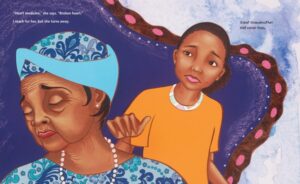 First and foremost, this is not a fuzzy grandparent (or great-grandparent) book. There are plenty of fuzzy books out there, filled to brimming with warm snuggly feelings. If that is the kind of book you require then grab yourself the nearest Nancy Tillman and content yourself accordingly. What we have here instead is a kind of character study. Whatever expectations you carry into this book, they will be upended by the text. Nell is an amazing character, one that I’ve never seen in book of this sort. Her prickly nature may well hide that “broken heart” she mentions obliquely, but it could just as easily hide more prickles. We get three distinct memories of her past, but it’s a single wordless two-page spread that probably says more about her than anything else. As an adult, I found myself speculating about her life. How perhaps she had dreams of dancing professionally but that she put those dreams aside when she had her children at a very young age. No kid is going to read into Nell what I have. That’s what makes reading this book so dynamic. Come for the prickly relative. Stay for the enticing, unknowable back story.
First and foremost, this is not a fuzzy grandparent (or great-grandparent) book. There are plenty of fuzzy books out there, filled to brimming with warm snuggly feelings. If that is the kind of book you require then grab yourself the nearest Nancy Tillman and content yourself accordingly. What we have here instead is a kind of character study. Whatever expectations you carry into this book, they will be upended by the text. Nell is an amazing character, one that I’ve never seen in book of this sort. Her prickly nature may well hide that “broken heart” she mentions obliquely, but it could just as easily hide more prickles. We get three distinct memories of her past, but it’s a single wordless two-page spread that probably says more about her than anything else. As an adult, I found myself speculating about her life. How perhaps she had dreams of dancing professionally but that she put those dreams aside when she had her children at a very young age. No kid is going to read into Nell what I have. That’s what makes reading this book so dynamic. Come for the prickly relative. Stay for the enticing, unknowable back story.
What I would really like to praise in this review, if nothing else, is just how deftly author Vaunda Micheaux Nelson parses words into sentences that swell with meaning. Take, for example, the moment when our heroine enters Great-Grandmother Nell’s bedroom. She considers playing with the cloth ballerina on the best but abstains, saying, “her expression makes me think she might tell.” Later she kisses her great-grandmother in her sleep. “Even asleep, Great-Grandmother Nell is scary. But I like her that way.” The very last line? “She won’t know”. It would be fascinating to see Nelson’s original manuscript. Was it just this sparse and spare? Or was it much longer and cut down to the bone in the editing process? Whichever it was, it works.
 The child in this book is much like the child who will be reading it with an adult. Both she and they sense that there is more at work here than meets the eye. And it is the art by Elizabeth Zunon that backs that feeling up. Elizabeth Zunon has been a force to reckon with for years. I first noticed her when she illustrated William Kamkwamba’s The Boy Who Harnessed the Wind, though I unknowingly had already been a fan of hers when she illustrated Jeanne Harvey’s My Hands Sing the Blues. In Don’t Call Me Grandma she begins with a straightforward contemporary story. Even then, her endpapers start telling the tale long before the words do (not counting the title). She fills these early pages with strings of pearls. Fat pearls, small pearls, pink and gray and white pearls. Note that in the text there is just one mention of those pearls, and it’s in the context of a lot of other things on Nell’s dressing table. But Zunon is getting a grip on her personality in her own way. Because of her we get a distinct sense of Great-Grandmother’s style, poise, and dignity. There are fun little details too, like the family peering out through the window as Nell gives a singing bird what for and how to. Zunon also lends Nell a humanity on the sidelines. When her great-granddaughter looks around her room we see Nell observing affectionately from the sides (though she’d be the first to deny it if you accosted her with the evidence). Then there are the memories. Depicted as splotchy watercolors, Zunon subtly changes her style to indicate how some memories are crystal clear even as they blur and go soft around the edges. The two-page spread of objects representing other memories (everything from photographs of Civil Rights marchers to tickets to an Alvin Ailey ballet) will require giving child readers some context. Nothing wrong with that. Sit them down and explain each thing you see. Don’t recognize something? Look it up!
The child in this book is much like the child who will be reading it with an adult. Both she and they sense that there is more at work here than meets the eye. And it is the art by Elizabeth Zunon that backs that feeling up. Elizabeth Zunon has been a force to reckon with for years. I first noticed her when she illustrated William Kamkwamba’s The Boy Who Harnessed the Wind, though I unknowingly had already been a fan of hers when she illustrated Jeanne Harvey’s My Hands Sing the Blues. In Don’t Call Me Grandma she begins with a straightforward contemporary story. Even then, her endpapers start telling the tale long before the words do (not counting the title). She fills these early pages with strings of pearls. Fat pearls, small pearls, pink and gray and white pearls. Note that in the text there is just one mention of those pearls, and it’s in the context of a lot of other things on Nell’s dressing table. But Zunon is getting a grip on her personality in her own way. Because of her we get a distinct sense of Great-Grandmother’s style, poise, and dignity. There are fun little details too, like the family peering out through the window as Nell gives a singing bird what for and how to. Zunon also lends Nell a humanity on the sidelines. When her great-granddaughter looks around her room we see Nell observing affectionately from the sides (though she’d be the first to deny it if you accosted her with the evidence). Then there are the memories. Depicted as splotchy watercolors, Zunon subtly changes her style to indicate how some memories are crystal clear even as they blur and go soft around the edges. The two-page spread of objects representing other memories (everything from photographs of Civil Rights marchers to tickets to an Alvin Ailey ballet) will require giving child readers some context. Nothing wrong with that. Sit them down and explain each thing you see. Don’t recognize something? Look it up!
A woman of my acquaintance used to make a big show of objecting to any and all picture books that depicted grandmothers as white-haired, doddering old women, tottering on the very edge of the grave. To her mind, there should be at least as many books that show those women as resourceful, spry, and full of energy. Great-Grandmothers probably have few books where they’re wrecking havoc with the universe. Generally speaking they just dodder and die. There will be no doddering and certainly no dying in Don’t Call Me Grandma, though. Nell isn’t just a character. She comes off the page like a full-blown human being, warts and all (just an expression – Nell would take me to the cleaners if she heard me indicating she has any warts). Sharp and smart, this is one of those picture books I’d like to see more of. Which is to say, stories I’ve never seen before.
On shelves now.
Source: Final copy sent from publisher for review.
Like This? Then Try:
Professional Reviews:

By:
Sue Morris @ KidLitReviews,
on 3/4/2016
Blog:
Kid Lit Reviews
(
Login to Add to MyJacketFlap)
JacketFlap tags:
Middle Grade,
outdoors,
trust,
survival,
books for boys,
camping,
Carolrhoda Books,
integrity,
Morse Code,
Elizabeth Atkinson,
Lerner Publishing Group,
Library Donated Books,
6-Stars TOP BOOK,
Top 10 of 2016,
The Island of Beyond,
relationships,
Add a tag
My calendar said today is World Read Aloud Day. As you can see, it’s wrong. This took place on February 24th. Not sure how I messed this up, but really, can’t any day be a good day to read aloud? If you know a middle grader who is unable to read, even if only for today, …
By:
Sue Morris @ KidLitReviews,
on 11/29/2015
Blog:
Kid Lit Reviews
(
Login to Add to MyJacketFlap)
JacketFlap tags:
Children's Books,
holidays,
Picture Book,
Poetry,
Santa,
Christmas,
Favorites,
Bob Raczka,
North Pole,
Carolrhoda Books,
Holiday Book,
Haikus,
Lerner Publishing Group,
5stars,
Chuck Groenink,
Library Donated Books,
Santa Clauses: Short Poems from the North Pole,
Add a tag
Last year, I was hospitalized from September until March and was unable to bring you this wonderful Christmas book from Bob Raczka and Chuck Groenink (Carolrhoda). I love this picture book and its illustrations of life at the North Pole–the simplified, down-to-earth version–and Santa’s poems, one haiku for each day, from December 1st to 24th. I am …
By:
Sue Morris @ KidLitReviews,
on 5/23/2015
Blog:
Kid Lit Reviews
(
Login to Add to MyJacketFlap)
JacketFlap tags:
family,
Africa,
Middle Grade,
Kenya,
Favorites,
Series,
Books for Boys,
Inc.,
Lerner Publishing Group,
5stars,
Library Donated Books,
Darby Creek,
Lisa Doan,
Ivica Stevanovic,
get-rich-schemes,
Jack and the Wild Life,
Jack at the Helm,
Jack the Castaway,
Add a tag
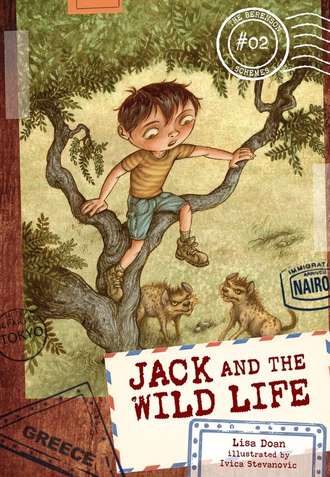
#02 Jack and the Wild Life 
Series: The Berenson Schemes
Written by Lisa Doan
Illustrated by Ivica Stevanovic
Darby Creek 9/01/2014
144 pages Age 9—12
“After a wild plan by his parents left Jack stranded in the Caribbean, the Berenson family decided to lay out some rules. Jack’s mom and dad agreed they wouldn’t take so many risks. Jack agreed he’d try to live life without worrying quite so much. Then Jack’s parents thought up another get-rich-quick scheme. Now the family’s driving around Kenya. An animal attack is about to send Jack up a tree—alone, with limited supplies. As Jack attempts to outsmart a ferocious honey badger and keep away from an angry elephant, he’ll have plenty of time to wonder if the Berenson Family Decision-Making Rules did enough to keep him out of trouble.” [book jacket]
Review
The Berenson family adults are constantly trying to find an easy way to make a fortune, conjuring up one odd scheme after another. Jack is the one that pays the price for these awful plans, while his parents wander through life unaware of most everything around them, including their missing son. This makes for many comical situations and gives the series its heart. This time, the Berensons fly to Africa, Jack in tow, because, as Dad tells Jack,
“Your mum and I have invented a brand-new kind of tourism . . . a surefire moneymaking opportunity.”
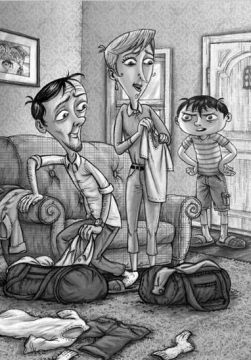 They plan to build a tourist camp where people can live like a real Maasai tribe. Using mud, sticks, grass, and more mud, Jack’s parents plan to build the Maasai mud-huts tourists will gladly rent to experience tribal life (and a fence to keep out the lions). The best part of their plans, the two adults believe, is they need no money to build their attraction—Mother Nature supplies the materials. Jack is not thrilled. He finally had a “normal” life, a home, parents who held down real 9-to-5 jobs, and a new friend—Diana. Once summer began to fade into fall, Jack’s parents could no longer do that “grind.” But this time things will be different: Jack’s parents will plan ahead, not take any risks, and not lose Jack. Changing their ways proves more difficult than the parents thought, as things do not go as planned, risks are taken, and, well, Jack . . . he ends up in a tree.
They plan to build a tourist camp where people can live like a real Maasai tribe. Using mud, sticks, grass, and more mud, Jack’s parents plan to build the Maasai mud-huts tourists will gladly rent to experience tribal life (and a fence to keep out the lions). The best part of their plans, the two adults believe, is they need no money to build their attraction—Mother Nature supplies the materials. Jack is not thrilled. He finally had a “normal” life, a home, parents who held down real 9-to-5 jobs, and a new friend—Diana. Once summer began to fade into fall, Jack’s parents could no longer do that “grind.” But this time things will be different: Jack’s parents will plan ahead, not take any risks, and not lose Jack. Changing their ways proves more difficult than the parents thought, as things do not go as planned, risks are taken, and, well, Jack . . . he ends up in a tree.
Poor Jack, now he is in Africa, stuck up a tree, while his parents—yet to realize Jack flew out of the rented Jeep—are trying to find the guide for their new camp. Jack must protect himself from animals on the ground and the ones that can get past the fence he built around the tree. He sleeps in the tree, eats in the tree, and fears for his life—and the life of Mack, Diana’s stuffed monkey—in the tree. The last time his parents had a get-rich-quick scheme, Jack feared for his life on a deserted island. (#1 – Jack the Castaway reviewed here).
 The Berenson Schemes is a wonderful series, especially for kids that wish they could take control. With roles reversed, Jack acts more the parent, setting rules and following through. Meanwhile, Jack’s parents act more like spoiled, unruly children, who care about themselves first and Jack second. They do love their son, but cannot get it together as adults. In book #2, Jack and the Wild Life, the family has new decision-making rules in the hopes that Jack’s parents will be parents that are more responsible. As Jack makes a tree-bed out of duct tape and reads his Kenya guide, he thinks maybe the rules are not working as he had hoped they would.
The Berenson Schemes is a wonderful series, especially for kids that wish they could take control. With roles reversed, Jack acts more the parent, setting rules and following through. Meanwhile, Jack’s parents act more like spoiled, unruly children, who care about themselves first and Jack second. They do love their son, but cannot get it together as adults. In book #2, Jack and the Wild Life, the family has new decision-making rules in the hopes that Jack’s parents will be parents that are more responsible. As Jack makes a tree-bed out of duct tape and reads his Kenya guide, he thinks maybe the rules are not working as he had hoped they would.
I love the black and white illustrations. Stevanovic does a great a job of enhancing the story, giving readers a view into Jack’s situation and his emotions. I wish I had more images to show readers. The full-page illustrations are fantastic and have been in both books. By the end of the story, Jack’s parents may see the errors of their ways and promise Jack they will try harder to change . . . until the next edition, when they tire of being adults, devise a new scheme, and hook Jack into their plans. The Berenson Schemes #2: Jack and the Wild Life is great fun and I look forward to each new scheme and Jack’s consequences for merely being his parents’ child. Kids will love the mayhem Doan creates and the magic in Stevanovic’s illustrations. Book #3: Jack at the Helm, released this past March, 2015.
JACK AND THE WILD LIFE (THE BERENSON SCHEMES #2). Text copyright © 2014 by Lisa Doan. Illustrations copyright © 2014 by Lerner Publishing Group, Inc. Reproduced by permission of the publisher, Darby Creek, Minneapolis, MN.
Purchase Jack and the Wild Life at Amazon —Book Depository—iTunes—Darby Creek.
—Book Depository—iTunes—Darby Creek.
Learn more about Jack and the Wild Life HERE.
CCSS Guide for Teachers HERE.
Meet the author, Lisa Doan, at her website: http://www.lisadoan.org/
Meet the illustrator, Ivica Stevanovic, at his website: http://ivicastevanovicart.blogspot.com/
Find more middle grade books at the Darby Creek website: http://bit.ly/DarbyCreek
Darby Creek is a division of Lerner Publishing Group, Inc.
The Berenson Schemes
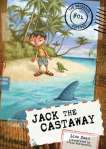
#1 – Jack the Castaway
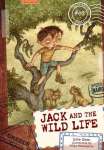
#2 – Jack and the Wild Life
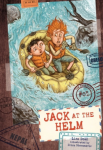
#3 – Jack at the Helm
#01 – Jack and the Castaway – 2015 IPPY Gold Medalist for Juvenile fiction
x
x
.
Copyright © 2015 by Sue Morris/Kid Lit Reviews. All Rights Reserved
Review section word count = 518

Filed under:
5stars,
Books for Boys,
Favorites,
Library Donated Books,
Middle Grade,
Series Tagged:
Africa,
Darby Creek,
family,
get-rich-schemes,
Inc.,
Ivica Stevanovic,
Jack and the Wild Life,
Jack at the Helm,
Jack the Castaway,
Kenya,
Lerner Publishing Group,
Lisa Doan 







By:
Sue Morris @ KidLitReviews,
on 4/3/2015
Blog:
Kid Lit Reviews
(
Login to Add to MyJacketFlap)
JacketFlap tags:
Picture Book,
NonFiction,
Middle Grade,
biology,
Millbrook Press,
Books for Boys,
zoology,
naturalist,
Lerner Publishing Group,
Rebecca L. Johnson,
5stars,
Library Donated Books,
quirky animal defense mechanisms,
When Lunch Fights Back: Wickedly Clever Animal Defenses,
Add a tag
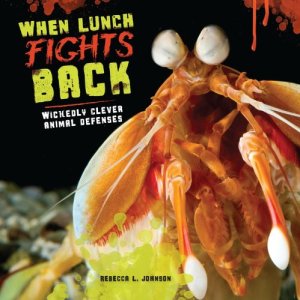 x
x
x
When Lunch Fights Back: Wickedly Clever Animal Defenses
Written by Rebecca L. Johnson
Millbrook Press 9/1/2015
978-1-4677-2109-7
Nonfiction Picture Book
48 pages Age 9 to 14
A Junior Library Guild Selection
“In nature, good defenses can mean the difference between surviving a predator’s attack and becoming its lunch. Some animals rely on sharp teeth and claws or camouflage. But that’s only the beginning. Meet creatures with some of the strangest defenses known to science. How strange? Hagfish that can instantaneously produce oodles of gooey, slippery slime; frogs that poke their own toe bones through their skin to create claws; young birds that shoot streams of stinking poop; and more.” [book jacket]
Review
“On Earth the challenge of survival is a real and serious business. In the wild, every living thing is constantly at risk of being eaten by something else.”
Life is a bed of strange abilities as explored in When Lunch Fights Back. These animals—and one plant—have incredible defense mechanisms. You will wonder what other odd defense mechanisms other animals might possess. I do. It also made me wonder why humans have limited natural defense abilities. Hitting, screaming, and kicking are all fine defenses, but wouldn’t it be fantastic to have some of these abilities.
1. Cover your predator with thick, slimy, goo. (Atlantic Hagfish)
2. Extend your fingers so the bones protrude through the skin like sharp claws. (African Hairy Frog)
3. Bulge out your eyes and shoot a deadly stream of blood into a predator’s mouth. (Texas Horned Lizard)
Stuff of science fiction? Nope. When Lunch Fights Back contains animals with these abilities and much more. This nonfiction picture book for older kids is a fascinating read. There is enough “yuck” to entertain kids and the author supplies the science behind those incredible abilities, making this a great adjunct text for science teachers. Author notes, a glossary, index, bibliography, and extra resources are included.

Johnson writes in a manner that should be accessible to most middle grade aged kids. She introduces researchers and scientist in the “Science Behind the Story” sections. There is so much to learn and see it just might develop a child’s interest in the natural word. If the title does not peak a child’s interest, the images will. The color photographs highlight the noxious defenses and info-boxes give additional information about each animal (scientific name, location, habitat, and size).
Still, would it not be terrific if humans could spew putrid contents at a predator, much like a fulmar? Or, and this is a tad gross, turn our other check and “shoot streams of foul-smelling feces” at an attacker, much like a hoopoe chick can do? If you had the ability to slime an attacker, like the hagfish (aka “snot eel”), I doubt anyone would mess with you.
When Lunch Fights Back: Wickedly Clever Animal Defenses is an amazing look into some crazy species. Kids will love this book and teachers can use that interest to bring out the zoologist, biologist, or naturalist in her (or his) students. While a tad gross, and most definitely with a yuck value of 9, kids will enjoy When Lunch Fights Back: Wickedly Clever Animal Defenses. This kid did!
x
WHEN LUNCH FIGHTS BACK: WICKEDLY CLEVER ANIMA DEFENSES. Text copyright © 2015 by Rebecca L. Johnson. Reproduced by permission of the publisher, Millbrook Press, an imprint of the Lerner Publishing Group, Minneapolis, MN.
x
Purchase When Lunch Fights Back at Amazon —B&N—Book Depository—Lerner Books.
—B&N—Book Depository—Lerner Books.
x
Learn more about When Lunch Fights Back HERE.
Meet the author, Rebecca L Johnson, at her website: http://www.rebeccajohnsonbooks.com/
Find more MG Nonfiction at the Lerner Publishing Group website: https://www.lernerbooks.com/
Millbrook Press is an imprint of Lerner Publishing Group.

Copyright © 2015 by Sue Morris/Kid Lit Reviews
Filed under:
5stars,
Books for Boys,
Library Donated Books,
Middle Grade,
NonFiction,
Picture Book Tagged:
biology,
Lerner Publishing Group,
Millbrook Press,
naturalist,
quirky animal defense mechanisms,
Rebecca L. Johnson,
When Lunch Fights Back: Wickedly Clever Animal Defenses,
zoology 







By:
KidLitReviews,
on 3/19/2015
Blog:
Kid Lit Reviews
(
Login to Add to MyJacketFlap)
JacketFlap tags:
Children's Books,
NonFiction,
Middle Grade,
Favorites,
Series,
Books for Boys,
Lerner Publishing Group,
4stars,
Library Donated Books,
astronomy for kids,
Christine Zuchora-Walske,
physics for kids,
scientific misconceptions,
We're the Center of the Universe!: Science's Biggest Mistakes About Astronomy and Physics (Science G,
Add a tag

We’re the Center of the Universe!: Science’s Biggest Mistakes About Astronomy and Physics 
Series: Science Gets It Wrong
Written by Christine Zuchora-Walske
Lerner Publishing Group 9/1/2014
978-1-4677-3663-3
32 pages Age 9 to 12
x
“The universe circles around Earth.
Creatures live on the Sun.
You can tell the future by looking at the Stars.
At one time, science supported wild notions like these! But later studies proved these ideas were nonsense. Discover science’s biggest mistakes and oddest assumptions about physics and astronomy, and see how scientific thought changes over time.”
Review
Why is Pluto no longer a planet? What makes waves ebb and flow as they do? How did the universe begin? We’re the Center of the Universe will answer these questions and many more in this truly fascinating read. Even non-science buffs will find We’re the Center of the Universe interesting.
We’re the Center of the Universe packs a wild punch. Kids can learn about some of the greatest thinkers and scientists throughout history, and how their thoughts and postulates—once considered true—are now terribly off base. The physical sciences change with time. New information and tools improve research. New scientists bring new ideas. We’re the Center of the Universe will have kids laughing—and thinking—about the beliefs people once held, but as the author states,
“. . . in the future, people might think our scientific ideas are pretty goofy too!”
I loved the book and found it difficult to put down. Well-written and well-researched, kids will be drawn into to this primer on the misconceptions regarding our world and universe, specifically in the areas of physics and astronomy. The illustrations and photographs are fantastic and teachers can quickly incorporate We’re the Center of the Universe into the Common Core requirements.
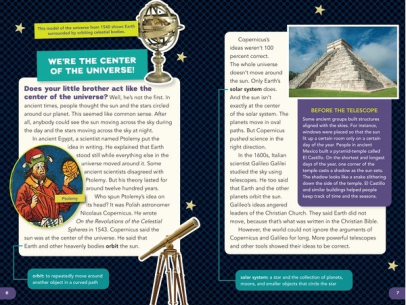
Ms. Christine Zuchora-Walske knows how to write non-fiction for children. We’re the Center of the Universe is not a dry textbook, but rather a great adjunct text, a quick reference, and a fun read. In the resources section, she thoughtfully summarizes each book and website so readers can quickly find more information about whatever sparked their interest.
From ancient times to modern times, science continues to change and, sometimes, old ideas and thoughts are simply funny or just odd. Kids will find much to laugh about and learn inside the covers of We’re the Center of the Universe.
x
WE’RE THE CENTER OF THE UNIVERSE! : SCIENCE’S BIGGEST MISTAKES ABOUT ASTRONOMY AND PHYSICS (SCIENCE GETS IT WRONG). Text copyright © 2014 by Christine Zuchora-Walske. Reproduced by permission of the publisher, Lerner Publishing Group, Minneapolis, MN.
x
Learn more about We’re the Center of the Universe! HERE.
Purchase We’re the Center of the Universe! at Amazon —B&N—Book Depository—Lerner Publishing Group.
—B&N—Book Depository—Lerner Publishing Group.
Meet the author, Christine Zuchora-Walske at her Lerner bio: https://www.lernerbooks.com/contacts/987/Christine-Zuchora-Walske
View Christine Zuchora-Walske’s linkedin page: https://www.linkedin.com/pub/christine-zuchora-walske/5/998/847
Facebook: https://www.facebook.com/SevenCsEditorial
Find more from the Science Gets it Wrong series at the Lerner Publishing website: https://www.lernerbooks.com/
DON’T FORGET to VOTE for YOUR FAVORITE BEST BOOK for 2014 HERE.
x

x
Copyright © 2015 by Sue Morris/Kid Lit Reviews
Last Chance! VOTE for YOUR FAVORITE BEST BOOK for 2014 HERE.
Filed under:
4stars,
Books for Boys,
Children's Books,
Favorites,
Library Donated Books,
Middle Grade,
NonFiction,
Series Tagged:
astronomy for kids,
Christine Zuchora-Walske,
Lerner Publishing Group,
physics for kids,
scientific misconceptions,
We're the Center of the Universe!: Science's Biggest Mistakes About Astronomy and Physics (Science Gets It Wrong) 







By:
Sue Morris,
on 9/12/2014
Blog:
Kid Lit Reviews
(
Login to Add to MyJacketFlap)
JacketFlap tags:
Middle Grade,
farm life,
fairies,
children's book reviews,
middle grade novel,
Debut Author,
feuds,
Debut Book,
Lerner Publishing Group,
4stars,
Library Donated Books,
Adam S. Doyle,
Charolrhoda Books,
Larissa Theule,
pig foot stew,
Add a tag
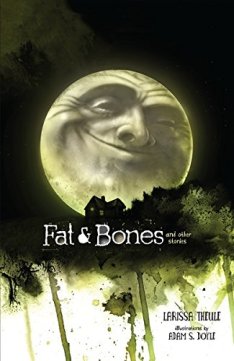 x
x
x
Fat & Bones: And Other Stories
Written by Larissa Theule
Illustrations by Adam S. Doyle
Carolrhoda Books 10/01/2014
978-1-4677-0825
Age 8 to 12 104 pages
x
x
“Welcome to Bald’s Farm. Well, perhaps it’s not Bald’s Farm anymore. The old man has kicked the bucket, setting off a wave of conflict from the muddy pig pen to the tall wheat fields. In this darkly funny, slightly supernatural chain of tales, no creature is safe. Not Leonard Grey, a spider with sophisticated tastes. Not Esmeralda, a resentful one-footed pig. Not Tulip, a plant with a mean streak. And as for Bones, the old man’s son, and Fat, his winged rival? They’ll learn that danger lurks in the strangest of places . . .”
Opening
“Fat stood on the topmost branch of the tree, gazing in the direction of the farmhouse.”
The Story
Bones is the son of his father, the farm owner, who has most recently passed away. Fat is the former farmer’s fairy. They hate each other with a passion usually reserved for love. Now that Bone’s father has died, Bones will run the farm and his first priority: get rid of excess Fat.
In the span of one day, Bones tries to take out Fat, who tries to take out Bones. The pigs must move around on less and less feet to supply Bones with his favorite meal of pig foot stew. Pa may be dead, but Bones is still hungry. Ma, who is crying herself blind ventures out to the pigpen to grab a foot. Which one does she get?
Leonard’s family thinks he is the strangest spider that has ever spun a web. He cannot sneak and lives alone. He reads poetry while drinking herbal tea. Down below, Fat is making a new potion and needs the fresh blood of a spider. Leonard picks this moment to prove he can sneak. He cannot.
The Dead Man Song is for Priscilla Mae, the escaped spider for which Leonard has found love. She sees a group of animals honoring the dead farmer’s passing. Jimmy’s in Love pits mouse against mouse for the love of a mouse across the kitchen floor. Cat lurks on the floor, waiting for a wandering mouse. Sometimes he greets the mouse.
“Good afternoon, mousie-pie.”
Sometimes he pounces. Occasionally, that tricky cat does both. A mouse just never knows. Jimmy decides to take a chance but the floor is full of water—salty, tear stained water. Daisy and Tulip are the best of friends, sharing a puddle. All is well, until little sprouts move in and choke the water supply. Daisy and Tulip argue over how to get the sprouts to leave. The differences could mean the end of Tulip or Daisy.
Finally, Dog Alfred visits his Ma. Ma wants Alfred to go home. Alfred is sneezing. He has a cold. Alfred is upset, (and sets up Ma to speak a line of funny I love)
“Ma,” he said, [pleading voice] “I came all this way. I can’t go home now.”
“You live next door,” she said.

Review
Fat & Bones: And Other Stories is a fast read with only 104 pages. On those 104 pages, every word counts thanks to wonderful writing and editing. Each story has something to teach kids. In Leonard Grey III, Leonard learns it is okay to be yourself and love is better than alone. Fat feels morally obligated to care for his neighbors, even when he is the one who injured said neighbor. Be nice to others; get to know your neighbors; be responsible for each other. Esmeralda must decide which is more important, her jealousy and “revenge” or the good of the group. Fat and Bones is philosophy 101 for the middle grades.
I am not a fan of the cover. The moon grinning as it does is eerie, but that is the intent. The illustrations use dark tones of green, grey, and black. The image is often part of the shadow or obscured by it. I am sorry to say, I am not a fan of these illustrations. I love the individual stories. I enjoyed the way one story depends on the other. What happens in one story—or does not happen—affects another story, which affects another, and so on, yet none may be the wiser. Fat & Bones: And Other Stories play this out for kids in a way they can understand.
Humor plays a big part, easing what are actually dark themes of death, jealousy, war, and dejection into an enjoyable, funny story, odd as that may sound. Some kids may not like the darker, philosophical themes, while others will love them. I think the older the child, the more they will enjoy Fat and Bones.
These Seven stories, all intertwined, are a great read. Each story has a unique mix of characters from the Bald Farm. Each has their own plot, conflict, and resolution, yet the stories build on each other, need each other to live. There are many things kids can learn from these stories while reading a funny, heart-felt whole divided into parts that seem to stand on their own—because they do. Older kids will enjoy this book. Adults will enjoy this book. Fat & Bones: And Other Stories is the author’s debut.
FAT AND BONES AND OTHER STORIES. Test copyright © 2014 by Larissa Theule. Illustrations copyright © 2014 by Adam S. Doyle. Reproduced by permission of the publisher, Carolrhoda Books, Minneapolis, MN.
x
Purchase Fat and Bones at Amazon —B&N—Book Depository—Lerner Books—your favorite bookstore.
—B&N—Book Depository—Lerner Books—your favorite bookstore.
x
Learn more about Fat & Bones: And Other Stories HERE
Meet the author, Larissa Theule, at her twitter page: https://twitter.com/larissatheule
Meet the illustrator, Adam S. Doyle, at his website: http://adamsdoyle.com
Find other middle grade novels at the Carolrhoda Books blog: http://www.carolrhoda.blogspot.com/
Carolrhoda Books is a division of Lerner Publishing Group.

x
Copyright © 2014 by Sue Morris/Kid Lit Reviews
Filed under:
4stars,
Debut Author,
Library Donated Books,
Middle Grade Tagged:
Adam S. Doyle,
Charolrhoda Books,
children's book reviews,
Debut Book,
fairies,
farm life,
feuds,
Larissa Theule,
Lerner Publishing Group,
middle grade novel,
pig foot stew 







By:
Sue Morris,
on 8/10/2014
Blog:
Kid Lit Reviews
(
Login to Add to MyJacketFlap)
JacketFlap tags:
Picture Book,
picture books,
Favorites,
bears,
children's book reviews,
Books for Boys,
bedtime story,
Michael Foreman,
fathers and sons,
Lerner Publishing Group,
5stars,
Library Donated Books,
Andersen Press Ltd,
Andersen Press U. S. A.,
I Love You Too!,
Children's Books,
Add a tag
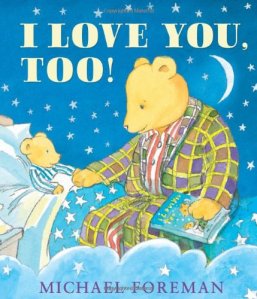 .
.
I Love You, Too! 
By Michael Foreman
Andersen Press U. S. A. 3/01/2014
978-1-4677-3451-6
Age 4 to 8 32 pages
.
“Little Bear doesn’t want to go to sleep, so he tries everything he can think of to distract his father, and in the end it’s an exhausted dad who falls asleep!”
Opening
“Dad finished the bedtime story and gently closed the book.”
The Story
Dad Bear tucks his son into bed, reads him a story, and tells his son he loves him. Little Bear has no intentions of going to sleep and so he starts up a back-and-forth he and his dad have done many times: “I love you, I love you more.” It starts out simply and Dad just wants his son to go to sleep.
“I love you three,” said Little Bear, laughing.
“I love you four. Now go to sleep.” said Dad.
“I love you five,” said little Bear.
“I love you even more than that. Now it’s time to sleep,” said Dad.
No, Dad, it is not quite time for bed. Little Bear continues, bringing in his toys, which he loves his dad more than. Dad replies with a simple I love you more, but it will not suffice his son. The boy loves his father more than leaves and birds, all the snowflakes of winter, flowers of summer, colors of the rainbow, and the stars in the sky. To each of his son’s “I love you more than,” Dad replies, “I love you more,” or some variation of this reply. Finally, Dad says,
“You’re only saying that because you don’t want me to go down stairs.”
“No, Dad. It’s because I love you.”
“I love you, too,” said Dad.
“I love you three . . . “
Review
I Love You, Too is a sweet story between a father and son. Picture books need a few more stories involving Dad, who does not get the representation Mom gets in picture books. Poor Dad is usually off to work and, if he is in the book, it is breakfast time and Dad is leaving for work. “Bye kids,” said Dad.
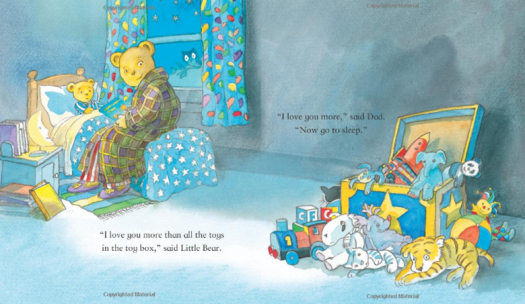
Little Bear uses his imagination to tell his dad all the ways in which he loves him more than. When Little Bear tells dad he loves him more than all his toys, which are in a corner overflowing out of a toy box, the toys look dejected. The stuffed tiger looks downcast, the donkey appears to have shed a tear, and the others—cat, elephant, panda bear, and bunny,—all look unhappy. Little Bear takes dad up into a tree, into the snow, (where there is a snowbear), into a field of flowers, into the ocean, and onto a sandy beach (where dad is buried under the sand sans his head). In every adventure, Dad smiles and replies that he loves his son and it is time for sleep. Stubborn, but happy, Little Bear ignores his father’s admonitions.
The illustrations, all beautifully done in rich watercolors, welcome the two bears, alone for Little Bear’s love-you-more-than-these adventures. Little Bear’s imagination has these two anthropomorphic brown bears perfectly outfitted in each place Little Bear takes them. As Little Bear finds new ways to love his father more than, the two transport into Little Bear’s imagination to that place, be it a field of flowers, a rainy day with puddles to play in, or a starry sky to float through, Dad is as happy as Little Bear, wherever Little Bear’s imagination has taken them. I love how Foreman puts the circle of love in motion once more when Dad said, “I love you, too” and Little Bear takes off with his I love you three, but we never find out what those three things he loves dad more than. Dad has fallen asleep on Little Bear’s bed. Little Bear has gotten his wish. Dad is not going back downstairs. Little Bear picks up the picture book Dad had read him: I Love You, Too!
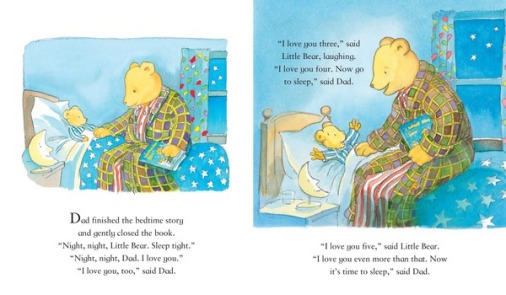
I Love You, Too makes a wonderful bedtime story, though you may find yourself trapped in the “I love you more” merry-go-round, not this is a bad place to be stuck. The story and the illustrations will evoke laughter, smiles, and many “I love you’s” which one can never hear enough. Children will love this story and will soon be using their own imaginations when deciding how much they love a parent more than. I Love You, Too will send many children off to dream land happy and content. If Da Bear is any indication, parents will quickly dose off to their own happy dreamland, maybe even before the last “I love you more than . . . “is said.
I LOVE YOU, TOO! Text and illustrations copyright © 2013 by Michael Foreman. Reproduced by permission of the US distributer, Lerner Publishing Group, Minneapolis, MN.
. First published in Great Britain in 2013 by Andersen Press, Ltd.
.
Purchase a copy of I Love You, Too! at Amazon —B&N—Book Depository—Lerner Publishing—Andersen Press—at your favorite bookstore.
—B&N—Book Depository—Lerner Publishing—Andersen Press—at your favorite bookstore.
.
Learn more about I Love You, Too! HERE.
Meet the author / illustrator, Michael Foreman, at his wiki page: http://en.wikipedia.org/wiki/Michael_Foreman_%28author_/_illustrator%29
Find more great books at the Lerner Publishing Group website: https://www.lernerbooks.com/
Find even more books at the Andersen Press U. S. A. website: http://www.andersenpress.co.uk/
Andersen Press U. S. A. is an imprint of Andersen Press Ltd.
.
Also by Michael Foreman, released in 2014
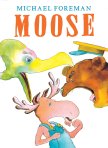
Moose
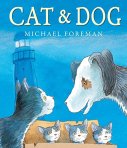
Cat & Dog
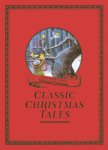
Classic Christmas Tales
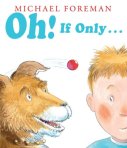
Oh! If Only…
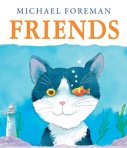
Friends
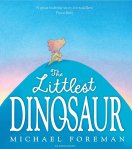
The Littlest Dinosaur
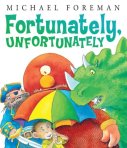
Fortunately, Unfortunately

War Game: Village Green to No-Man’s-Land
(ages 8 to 10)
m
m
m
m
m
m
m
m
m
m
m

m
m
copyright © 2014 by Sue Morris/Kid Lit Reviews
Filed under:
5stars,
Books for Boys,
Children's Books,
Favorites,
Library Donated Books,
Picture Book Tagged:
Andersen Press Ltd,
Andersen Press U. S. A.,
bears,
bedtime story,
children's book reviews,
fathers and sons,
I Love You Too!,
Lerner Publishing Group,
Michael Foreman,
picture books 







By:
Sue Morris,
on 7/23/2014
Blog:
Kid Lit Reviews
(
Login to Add to MyJacketFlap)
JacketFlap tags:
Children's Books,
Picture Book,
picture books,
Favorites,
Series,
children's book reviews,
Lerner Publishing Group,
Howard B. Wigglebottom,
Howard Binkow,
5stars,
bad manners,
good manners,
Library Donated Books,
Reverend Ana Rowe,
Taillefer Long,
Thunderbolt Publishing,
Add a tag
 Howard B. Wigglebottom and Manners Matters
Howard B. Wigglebottom and Manners Matters
written by Howard Binkow & Reverend Ana
illustrated by Taillefer Long
Thunderbolt Publishing 1/01/2013
978-0-9826165-9-8
Age 4 to 8 32 pages
.
“Using humor and a light approach this book introduces to 5 to 8 year olds the concept “to have good manners is to do and say only what makes people feel good and comfortable.” The thirteenth book in the award winning Howard B. Wigglebottom series. Teacher and Counselor approved. Tips and lessons are included. Reviews and support resources are available at wedolisten.org”
Opening
“Howard Wigglebottom woke up very worried.”
The Story
Howard is worried about his friends not doing well in the Pup Scout’s Good Manners Competition. They compete in just five days. Oinky habitually burps, never saying, “Excuse me.”
Joey bumps into people and never says, “Excuse me.” Kiki uses unkind words, which is not nice. Even the Snorton Twins lack patience, cutting in l line, not willing to wait their turn. Howard must deal with a very ragamuffin group for this year’s contest. He needs help and enlists a coach. All good teams have coaches, right? Howard decided to get a coach for the manners team.
Howard cannot find a grown-ups willing to coach. Then he asked Ms. Owlee, who observed each kid’s manners at home, school, the park, and everywhere else they went. When the team had gathers for a coaching session, Ms. Owlee had basically one thing to tell the team. Some may say it’s a trick, because it involves secret magical words, but if it is a secret, no one will find out. Can Ms. Owlee coach Howard’s Manners Team on to victory?
Review
Howard B. Wigglebottom and Manners Matter deals with many rude and yucky behaviors. Howard’s team coach, Ms. Owlee, takes a different from most approach to the team’s bad manner problems. Ms. Owlee not only shows the kids the right thing to do in their particular situations, she also gets them to understand why good manners are so important. Some of the kids burp and others fart but no one said, “Excuse me.” Part of the problem is that we often find those behaviors funny. This is especially true with young boys and fathers—when mom is not around. To be honest, sometimes it is funny, yet still not nice.
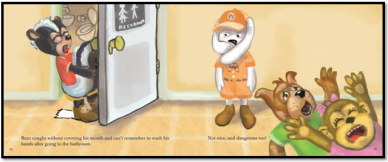
I like the secret magic words—two words—Ms. Owlee has the kids remember. Whenever they do something rude or gross, like fart or burp, they are to recall this secret. That, in turn, will help the kids remember to use manners. It works. This makes a lot of sense to me. If I know the reason behind something, I am more likely to comply with whatever it is. Understanding can go a long way in changing behavior. The next time Buzz sneezes, he remembers why he should show good manners and says, “Sorry for not covering my face.” Well, it’s a start. Nothing in the story deals with actions, only good manner words.
The magical words work with all the team members, who are now ready for the Manners Competition. In the end, Howard is pleased with his team’s performance. The entire team is thrilled. The story is an interesting way of conveying good manners to young children. Ages 4 to 8, and even younger, need constant reminders about manners. Reading Howard B. Wigglebottom and Manners Matter can entertain kids while instilling the good manners they so desperately need to learn at this age. Kids can read, or listen while someone else reads, the book over and over, ingraining the information and the difference between good and bad manners. Repetition is a master at helping children learn. This is why so many young children’s books use repetitive lines in the stories.
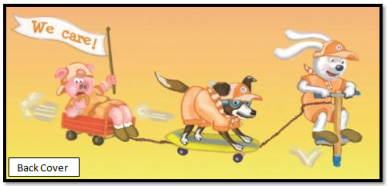
The illustrations are cute. The animals all have human qualities and characteristics, a technique called anthropomorphism. The cute skunk, pig, alligator, dogs—Howard Wigglebottom is a bunny–, and many other animals, will entertain kids. They have bright eyes, big smiles, and wear a variety of clothes, some of which are funny. The mouse Kiki speaks to nicely reminds me of the Monopoly man, with his top hat and long circus-style coat. I love the turtle that needs a walker to get around. Her curved shell easy looks like a hunch back, or a woman with osteoarthritis. The characters, all animals, range from very young to very old. I like this mix of young and old, similar to what children see and deal with daily.
The Howard B. Wigglebottom and Manners Matter is one in a series of books devoted to helping young children grow up with the characteristics they need for success. Series titles always begin, Howard B. Wigglebottom . . . Titles include . . . Learns to Listen; Learns About Bullies; Learns too Much of a Good Thing is Bad; On Yes and No: A Fable about Trust; and the Power of Giving: A Christmas Story, to name a few in this ever-growing series (13 thus far). The Howard B. Wigglebottom stories are well-written, interesting stories that will hold children’s attention from start to finish; perfect for use in the classroom. Young children love to learn and they love to please, making this a great age to learn and reinforce good manners. With the gentle persuasiveness of Howard’s friend, Ms. Owlee—a very smart owl in deed—Howard B. Wigglebottom and Manners Matter will help and encourage many children and their parents.
Oh, what was that? What are Ms. Owlee’s secret magical words? Well, it is a secret, and . . . you didn’t say, “Please.”
HOWARD B. WIGGLE BOTTOM AND MANNERS MATTER. Text copyright © 2013 by Howard Binkow Living Trust. Illustrations copyright © 2013 by Taillefer Long. Reproduced by permission of the publisher, Thunderbolt Publishing, through the distributor, Lerner Publishing Group, Minneapolis, MN.
Buy Howard B. Wigglebottom and Manners Matter at Amazon —B&N—Book Depository—iTunes—Lerner Books—WeDoListen—at your favorite bookstore.
—B&N—Book Depository—iTunes—Lerner Books—WeDoListen—at your favorite bookstore.
Learn more about the Howard B. Wigglebottom Series HERE.
**Meet the author, Howard Binkow, at his website: https://wedolisten.org/
For an informative interview with Howard Binkow, go HERE.
**Meet the author, Reverend Ana, at her website: https://wedolisten.org/
Meet the illustrator, Taillefer Long, at his website: http://childrensillustrationartist.com/
**Find more Howard B. Wigglebottom books at the Thunderbolt Publishing website: https://wedolisten.org/
Distributed by Lerner Publishing Group: https://www.lernerbooks.com/
**Collectively called the We Do Listen Foundation @ wedolisten.org
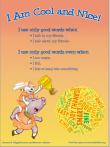 .
.
Free Poster HERE.
Listen to Song, find Lessons and Reflections HERE.
.
.

.
.
copyright © 2014 by Sue Morris/Kid Lit Reviews
Filed under:
5stars,
Children's Books,
Favorites,
Library Donated Books,
Picture Book,
Series Tagged:
bad manners,
children's book reviews,
good manners,
Howard B. Wigglebottom,
Howard Binkow,
Lerner Publishing Group,
picture books,
Reverend Ana Rowe,
Taillefer Long,
Thunderbolt Publishing 







By:
Sue Morris,
on 6/23/2014
Blog:
Kid Lit Reviews
(
Login to Add to MyJacketFlap)
JacketFlap tags:
Children's Books,
Picture Book,
freedom,
NonFiction,
Historical Fiction,
Favorites,
slavery,
children's book reviews,
Gretchen Woelfle,
Carolrhoda Books,
Declaration of Independence,
Lerner Publishing Group,
1776,
Alix Delinois,
American Revolutionary War,
Library Donated Books,
6 Stars TOP BOOK,
Top 10 of 2014,
Massachusetts Constitution of 1780,
Add a tag
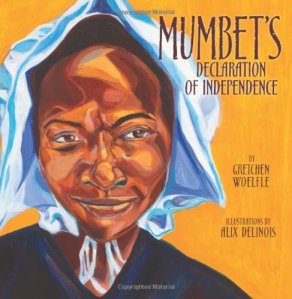 .
.
Mumbet’s Declaration of Independence 
by Gretchen Woelfle & Alix Delinois, illustrator
Carolrhoda Books 2/01/2014
978-0-7613-6589-1
Age 7 to 9 32 pages
.
“All men are born free and equal.” Everybody knows about the Founding Fathers and the Declaration of Independence in 1776. But the founders weren’t the only ones who believed that everyone had a right to freedom. Mumbet, a Massachusetts slave believed it too. She longed o be free, but how? Would anyone help her in her fight for freedom? Could she win against her owner, the richest man in town? Mumbet was determined to try. Mumbet’s Declaration of Independence tells her story for the first time in a picture book biography, and her brave actions set a milestone on the road toward ending slavery in the United States.”
Opening
“Mumbet didn’t have a last name because she was a slave. She didn’t even have an official first name. Folks called her Bett or Betty. Children called her Mom Bett or Mumbet. Others weren’t so kind.”
The Story
The year is 1776 and the United States begins its fight for freedom from the rule of the British by declaring on paper their Declaration of Independence. Mumbet is a slave owned by the richest man in town—the one who is usually the most powerful in town. Colonel John Ashley lived in Massachusetts and owed many businesses. He might have been kind, but his wife was definitely a cruel woman when it came to her husband’s slaves. Mumbet worked for Mrs. Ashley, usually in her kitchen. Mumbet hated that another human owned her, as wouldn’t you or I. She knew servants and hired hands could leave a cruel employer, but Mumbet had no recourse—she’s is property.
As the founding fathers gathered to write the Declaration of Independence, which started the seven-year war against the British, Mumbet served refreshments and tried to listen. The men were against British taxes and feared losing all their rights under British rule. As Mumbet listened, she heard one man say,
“He [the King of England] would make us slaves.”
And,
“Mankind in a state of Nature are equal, free, and independent . . .
God and Nature have made us free.”
After seven years of war against England, and freedom won, the town held a meeting to introduce The Massachusetts Constitution in 1780. It declared,
“All men are born free and equal.”
Mumbet wondered if that meant her. She approached Theodore Sedgwick, a young lawyer who helped draft the Declaration of Independence, and asked him to represent her in a fight for her personal freedom under the new Massachusetts law. He accepted. Mr. Sedgwick reminded the judge and jury that no law existed in Massachusetts making slaves legal and the new constitution now made them illegal. Would the judge and jury agree with Mr. Sedgwick and grant Mumbet her freedom—and the freedom of all slaves in Massachusetts in the process?
Review
Mumbet’s story, a true story, is an unusual biography in that I don’t recall hearing about this woman in any history class, not even American History. Mumbet had strength unseen except on rare occasions. To take your master to court to demand your freedom was a crazy idea. Even white women were still considered their husband’s chattel, why would a slave be above that. How was Mumbet going to convince a jury—not of her peers—and a judge—most likely friends with the richest man in town—that she deserved her freedoms for the same reason as the men deserved theirs from Britain? The new Massachusetts Constitution was not that old and here is this slave trying to gain her freedom, yet she is property. This must have caused some laughter, smirking, and hate. I find this story truly moving. Her new name became Elizabeth Freeman, a most deserved last name.
Mumbet’s clear and succinctly written story tells of an amazing, intelligent, and courageous woman who dared stand up for her rights when no one ever considered her to have rights. She entered a paternal courtroom, a jury not of her peers, and a town overflowing with curious citizens not all of which could have been happy Mumbet wanted freedom. It was probably more hostile, considering ever man probably stood to lose his slaves if Mumbet were successful. That makes Mumbet one of the strongest woman to have ever lived in the United States.
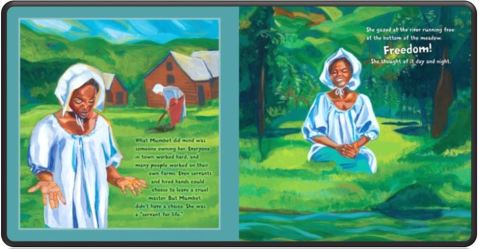
The illustrations are profoundly beautiful with deep rich colors. Even the end pages have an elegance to them. Alix Delinois represented that time in America accurately, with facial expressions that must have matched the frustration felt by most citizens, as the founding fathers wrote the Declaration of Independence. Mrs. Ashley’s cruelty is shockingly visible, immediately making you feel empathy for Mumbet and her daughter. For people sincerely wanting freedom and respect from the British, some were capable of much harm to others.
Thankfully, someone thought to write down Mumbet’s story giving the author great accounts of Mumbet’s life and challenges before, during, and after that day in court. After the story are two pages of author notes. They tell of the help the author received from Catharine Maria Sedgwick, Theodore Sedgwick’s daughter. Catharine wrote Mumbet’s story as it happened, leaving accurate historical documents from which this story was written. These notes are fascinating.Teachers would do well to keep Mumbet’s Declaration of Independence as an adjunct history lesson. It is a story not told in most history classes. Gretchen Woelfle’s impeccable research and storytelling skills gives us a story of slavery not well known in the very country in which it happened—until now. Mumbet’s Declaration of Independence should fascinate kids and adults alike.
MUMBET’S DECLARATION OF INDEPENDENCE. Text copyright © 2014 by Gretchen Woelfle. Illustrations copyright © 2014 by Alix Delinois. Reproduced by permission of the publisher, Carolrhoda Books, Minneapolis, MN.
Buy a copy of Mumbet’s Declaration of Independence at Amazon —B&N—iTunes—Book Depository—Carolrhoda Books—at your local bookstore.
—B&N—iTunes—Book Depository—Carolrhoda Books—at your local bookstore.
.
Learn more about Mumbet’s Declaration of Independence HERE.
Meet the author, Gretchen Woelfle, at her website: http://www.gretchenwoelfle.com/
Meet the illustrator, Alix Delinois, at his website: http://alixdelinois.com/home.html
Find more books a the Carolrhoda Books blog: http://carolrhoda.blogspot.com/
Carolrhoda Books is a division of Lerner Publishing Group, Inc. https://www.lernerbooks.com/
.
Also by Gretchen Woelfle
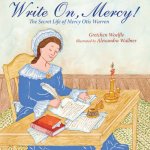
Write On, Mercy!: The Secret Life of Mercy Otis Warren

All the World’s a Stage: A Novel in Five Acts

The Wind at Work: An Activity Guide to Windmills
Also by Alix Delinois
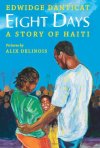
Eight Days: A Story of Haiti
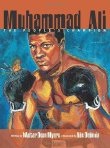
Muhammad Ali: The People’s Champion
.
.

Filed under:
6 Stars TOP BOOK,
Children's Books,
Favorites,
Historical Fiction,
Library Donated Books,
NonFiction,
Picture Book,
Top 10 of 2014 Tagged:
1776,
Alix Delinois,
American Revolutionary War,
Carolrhoda Books,
children's book reviews,
Declaration of Independence,
freedom,
Gretchen Woelfle,
Lerner Publishing Group,
Massachusetts Constitution of 1780,
slavery 







By:
Sue Morris,
on 6/20/2014
Blog:
Kid Lit Reviews
(
Login to Add to MyJacketFlap)
JacketFlap tags:
Children's Books,
Poetry,
NonFiction,
Favorites,
haiku,
children's book reviews,
Millbrook Press,
Brian P. Cleary,
lantern,
Lerner Publishing Group,
Library Donated Books,
6 Stars TOP BOOK,
Top 10 of 2014,
Andy Rowland,
Japanese poetry,
Add a tag
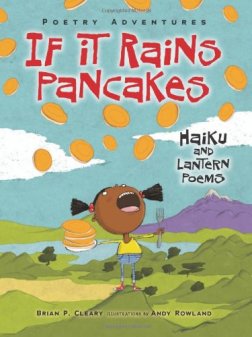 .
.
If It Rains Pancakes: Haiku and Lantern Poems 
by Brian P. Cleary
illustrated by Andy Rowland
Millbrook Press 1/1/2014
978-1-4677-4412-6
Age 7 to 10 32 page
.
“What is a haiku? It sounds like a sneeze. And isn’t a lantern a light source? Actually, they are two types of ancient Japanese poetry. Award-winning author Brian P. Cleary explains how each form works—and shows how these little poems can contain big surprises! If It Rains Pancakes is packed with poems to make you chuckle, puzzle, and ponder. And when you’ve finished reading, you can try your hand at writing your own haiku and lanterns!
“If it rains pancakes,
I’ll need no umbrella, just
syrup, fork, and plate.”
Opening
“Haiku is a short, Japanese form of poetry that has been around for more than four hundred years. That’s much longer than your teacher or your parents have been alive.”
Review
I like books that, even though written for a kid, teaches me something. I know a Haiku has 7 syllables in the first line, then 5 in the next, finishing with 7 in the third and final line. Everyone knows that, right? But, did you know that in Japan syllables are not what matters. Maybe they don’t even have syllables. In Japan, they count sounds and each Haiku has 17 sounds known as on (pronounced a faster than normal “one”). That I did not know, until I read If It Rains Pancakes. Traditionally, haikus are about nature, but Mr. Cleary takes liberties with this and writes Haikus on all sorts of kid-subjects: pets, pizza, and pancakes. I also love something else Mr. Cleary wrote,
“Poetry’s not a spectator sport, so try your hand at this ancient form, and be sure to have fun!”
I love fun as much as I love humor, so here is my haiku.
RAIN
It may rain kittens and pups.
It may rain water.
To be safe, watch where you step.
**I now challenge you to follow Mr. Cleary’s advice and write a haiku or a lantern (see below) in the comment section. I know there are lots of writers, poets, and aspiring writers and poets reading this blog. NOW is the time to show what you have!
Returning to the review: If you don’t like my haiku, Mr. Cleary wrote 20 for you in If It Rains Pancakes. Here are some of the titles, though many will not help you with the subject of the poem. Color Me Confused, City of Brotherly Lunch, The Mind and Yummy. There is one that is helpful to all of us not as poetically inclined as Mr. Cleary is. Kids will want to remember this one for when school resumes—much too soon.
HAIKU
When you’ve written one
without enough syllables,
you add words. Football.
The other half of If It Rains Pancakes is about Lanterns. This is all new to me. A lantern, or lanturne, is also Japanese. This poem has five lines. Line 1 is a 1-syllable noun and the subject of the poem. Line 2 “sheds light” (describes) the subject in two syllables. Line 3 has three syllables, line 4 has four, and line 5 has a 1-syllable word. The poem will look roughly like a lantern, hence the name. Mr. Cleary wrote 15 lanterns, all very cute, most very funny. Since I am a pet person and would have written a lantern about pets, and could not write one better than Mr. Cleary, the example I will share—by Mr. Cleary—is about a pet I know well.
Cat:
“Feed me.”
“Pet me too.”
“Feed me. Pet me.”
“Now.”
The illustrations, which play out the poems, are colorful and as crazy as the poem it represents. If the illustrations do not amuse you, I am lost for words. I love the images that perfectly match each poem. At the end of If It Rains Pancakes is a list of reference books to learn more about haikus and lanterns, and other poems, including one of the author’s, entitled “Rainbow Soup: Adventures in Poetry .” Finally there is a list of websites with more poetry activities, including one I had not heard of—but love the name—called Giggle Poetry at gigglepoetry.com
.” Finally there is a list of websites with more poetry activities, including one I had not heard of—but love the name—called Giggle Poetry at gigglepoetry.com
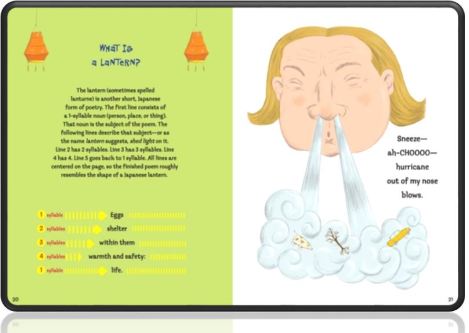
If It Rains Pancakes is a wonderful little book that packs a punch. Teachers would do well to have this on hand when teaching haikus or other Japanese poetry like lanterns. Kids will have fun learning about haikus and lanterns when reading these 35 mostly hilarious poems. Mr. Cleary is a master at teaching kids about writing of every type. If It Rains Pancakes upholds his genius.
IF IT RAINS PANCAKES: HAIKU AND LANTERN POEMS. Text copyright © 2014 by Brian P. Cleary. Illustrations copyright © 2014 by Andy Rowland. Reproduced by permission of the publisher, Millbrook Press, Minneapolis, MN.
Buy a copy of If It Rains Pancakes: Haiku and Lantern Poems at Amazon —B&N—Book Depository—Lerner Books—or your local bookstore.
—B&N—Book Depository—Lerner Books—or your local bookstore.
.
Learn more about If It Rains Pancakes: Haiku and Lantern Poems HERE.
Meet the author, Brian P. Cleary at his website: http://www.brianpcleary.com/
Meet the illustrator, Andy Rowland, at his website: http://andrewrowlandillustration.blogspot.com/
Find more books at the Millbrook Press website:
Millbrook Press is a division of Lerner Publishing Group: https://www.lernerbooks.com/
. .
.
Bookmarks (4) are available free HERE.
Also by Brian P. Cleary in 2014
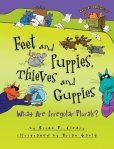
Feet and Puppies, Thieves and Guppies: What Are Irregular Plurals?
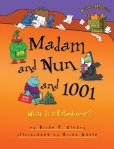
Madam and Nun and 1001: What Is a Palindrome?
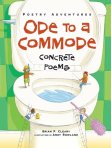
Ode to a Commode: Concrete Poems
-
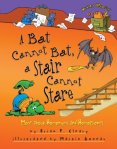
A Bat Cannot Bat, a Stair Cannot Stare: More About Homonyms and Homophones
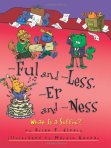
-ful and -less, -er and -ness: What Is a Suffix?
Review HERE
Also by Andy Rowland in 2014

Ode to a Commode: Concrete Poems
The Elves and the Shoemaker (November, 2014)
.
.

**PLEASE DON’T FORGET — SHOW YOUR STUFF! WRITE A HAIKU OR A LANTERN OR REALLY BLOSSOM AND WRITE BOTH IN THE COMMENTS! It is as easy as RAIN.
Filed under:
6 Stars TOP BOOK,
Children's Books,
Favorites,
Library Donated Books,
NonFiction,
Poetry,
Top 10 of 2014 Tagged:
Andy Rowland,
Brian P. Cleary,
children's book reviews,
haiku,
Japanese poetry,
lantern,
Lerner Publishing Group,
Millbrook Press,
poetry 







By:
Sue Morris,
on 6/11/2014
Blog:
Kid Lit Reviews
(
Login to Add to MyJacketFlap)
JacketFlap tags:
Laurent Richard,
Nicolas Ryser,
Children's Books,
Graphic Novel,
Middle Grade,
children's book reviews,
Books for Boys,
Graphic Universe,
proverbs,
martial arts,
Lerner Publishing Group,
4stars,
Library Donated Books,
Edward Gauvin,
graphic novel for kids,
Add a tag
 Tao, the Little Samurai #1: Pranks and Attacks!
Tao, the Little Samurai #1: Pranks and Attacks! 
by Laurent Richard & Nicolas Ryser, illustrator
translated by Edward Gauvin
Graphic Universe 1/14/2014
978-1-4677-2095-3
Age 7 to 11 64 pages
.
“Tao is studying martial arts at the famous Master Snow’s school. But no matter how hard he concentrates on his lessons, mischief gets in the way! Tai plays pranks and jokes around with his friends Ray, Lee, and Kat. He also struggles to get to school on time, learn new moves, and—most importantly—avoid doing his chores.”
Opening
“Ohboyohboy . . . this is gonna be tight. If I’m late, I’m gonna get chewed out! Hurry, hurry, hurry . . . home stretch . . .”
Review
Tao attends Master Snow’s martial arts school along with three friends, Ray, Lee, and his “not-girlfriend” Kat. Try as he might, Tao is late for school, and when there, has a hard time following Master Snow’s teachings. Each graphic novel page begins with a title, which is more like an oriental proverb. The second page is title “Showing off Can Spoil Dessert.” Tao is home and decides to practice annihilating blocks with a karate chop. He stacks three sets of two blocks to his right, left, and directly in front. Quickly, Tao chops with great force. “Bash! Bash! Bash!” Tao disintegrates every block, but his papa is unhappy with his son’s accomplishment—Tao used graham crackers as his cement blocks.
Kids, especially boys, will love Tao and his goofy ways. Tao tries but what he touches never goes right for him. I think reluctant readers will also like Tao. Rather than a 64-page story, there are 64 stories, one per page. Needing to stop is easy letting the reader–reluctant reader–go at their own pace, without becoming overwhelmed, or stressed. Remembering what happened is not necessary. If you don’t like the page where Tao is late for school, turn the page and a new situation will present itself. The stories have recurring characters that hang out with Tao, teach him, or guide him. So there is consistency in the Tai series.

The graphic novel is easy to following. The illustrations are bright and white lines mark each scene by placing them in boxes to divide the action. I found it was like reading a paragraph per block then moving on to the right for the next paragraph—only the blocks contained pictures not words. Some blocks do have a voice bubble with words, but those mostly set up or complete the joke on each page. Tao is completely for laughs and he succeeds. Needing help to put on his fencing outfit, not-my-girlfriend Kat helps and ties Tao up in bows—pretty pink bows—but Tao has no idea this is why his opponent is laughing.
A few pages I thought were especially good. Those included:
He Who Spies Gets a Black Eye
He Who Cannot Fly Must Avoid Falling
He Who Climbs Too Fast Falls Flat on His Face
The last involves Master Smith. Any page involving the Master is hilarious as he usually shows that age means nothing while performing some unusual human feat. After playing out all of the sage advice, the author takes readers “behind the scenes.” Here the author gives a short lesson on how Tao comes to life. The lesson includes writing voice bubbles, sketching characters and scenes, and colorizing the final images followed by black inking highlights so they stand out from the scene. The very last page lists the currently available editions of Tao. The color is light, almost like a transfer, which is what I thought it was. But, alas, it is not a transfer, so put those t-shirts away. Maybe next time.
Tao is a new graphic novel from Graphic Universe and rivals those published by Papercutz, the reigning king of graphic novels for kids. Tao is understandable and involves many situations most kids will face at some point in their life, karate not needed.
TAO THE LITTLE SAMURAI #1: PRANKS AND ATTACKS! Text copyright © 2011 by Laurent Richard. Illustrations copyright © 2011 by Nicolas Ryser. Translation copyright © 2014 by Edward Gauvin. Reproduced by permission of the publisher, Graphic Universe, Minneapolis, MN.
Buy Tao the Little Samurai #1: Pranks and Attacks at Amazon —B&N—Lerner Publishing—your local bookstore.
—B&N—Lerner Publishing—your local bookstore.
.
Learn more about the Tao the Little Samurai series HERE
Meet the author, Laurent Richard, at his website: http://www.laurent-richard.com/
Meet the illustrator, Nicolas Ryser, at his website:
Meet the translator, Edward Gauvin, at his website: http://www.edwardgauvin.com/
Find more graphic novels at Graphic Universe. blog: http://graphicuniverse.wordpress.com/
Graphic Universe is an imprint of Lerner Publishing Group
.
Also by Laurent Richard & Nicolas Ryser

Tao, the Little Samurai #2: Ninjas and Knock Outs!
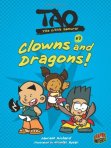
Tao, the Little Samurai #3: Clowns and Dragons!
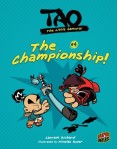
Tao, the Little Samurai #4: The Championship!

Tao, the Little Samurai #5: Wild Animals!
Also by Edward Gauvin
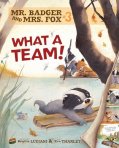
Mr. Badger and Mrs. Fox 3: What a Team!
Reviewed (#30) HERE.

Filed under:
4stars,
Books for Boys,
Children's Books,
Graphic Novel,
Library Donated Books,
Middle Grade Tagged:
children's book reviews,
Edward Gauvin,
graphic novel for kids,
Graphic Universe,
Laurent Richard,
Lerner Publishing Group,
martial arts,
Nicolas Ryser,
proverbs 







By:
Sue Morris,
on 6/6/2014
Blog:
Kid Lit Reviews
(
Login to Add to MyJacketFlap)
JacketFlap tags:
Middle Grade,
Favorites,
Series,
reluctant readers,
Debut Author,
middle grade books,
whale shark,
Lerner Publishing Group,
5stars,
Library Donated Books,
Caribbean Islands,
Darby Creek,
Lisa Doan,
Ivica Stevanovic,
Berenson Schemes series,
get-rich-quick schemes,
Jack Castaway,
Add a tag
 The Berenson Schemes #1: Jack the Castaway
The Berenson Schemes #1: Jack the Castaway 
by Lisa Doan
illustrated by Ivica Stevanovic
Darby Creek 1/01/2014
978-1-4677-1076-3
Age 7 to 12 152 pages
.
“Jack’s parents have been chased out of Tokyo, gone broke in Greece, and hosted Nairobi’s least successful safari. Next they’re taking Jack on a Caribbean vacation—whether Jack wants to go or not. The Berensons are about to start a snorkeling business. It’s their latest get-rich-quick scheme. With these experienced world travelers at the helm, what could go wrong?
Jack’s used to staying indoors and not taking chances. When his parents take him out on the water, he ends up shipwrecked. Now Jack has to survive on a tropical island . . . and avoid a whale shark that’s swimming near the beach.”
Opening
“Jack’s parents had finally returned from the heart of the Amazon. They stood at the front door, browned and emaciated.”
Review
Eleven-year-old Jack Berenson has lived most of his life indoors with his Aunt Julia, reading or playing video games . . . until a bus runs over Aunt Julia. With no other relatives, Jack must go with his parents. Richard and Claire Berenson have spent their lives traveling around the world chasing one get-rich-quick scheme to another. They are not rich. School starts soon and Jack wants to be there. Instead, his parents take him to an “undiscovered” Caribbean Island with plans to start a “lucrative” snorkeling business. They have a “master plan” which they follow, even after a failure. The Berensons decided a long time ago that nothing could go wrong if you have a master plan. Each time I say “Berenson” I can’t help but think of the bears and for some reason, it makes me laugh.
Jack’s parents are unreliable and self-interested to the point they often forget about Jack. They also have no idea how to be a parent or care for a child. The two act as if Jack is an adult as capable as they . . . well, as capable as most any adult. During the first trip out in the “new boat” Jack is expected to keep the skiff following his snorkeling parents, but instead the skiff runs out of gas, stranding Jack and a bird named Loco on an uninhibited island. His parents search for him—a couple of days later, but get distracted by some shiny thing or another and forget why they went out in the boat.
Jack the Castaway will entertain kids with laughs and twists. Most of the laughs come from dad, who makes daffy comments. Like when Jack tells his parents to enroll him in school.
“ . . . We’ll figure out this homeschooling thingy as soon as we get the business sorted out.” (said Mom)
“This is more than a thingy,” Jack said. “ . . . You would both be horrible at homeschooling. I doubt you’d even check my homework.”
His dad laughed. “We’d never give you homework.”

The illustrations pop up every so often and I wish there were more. The black and whites illustrations capture the action of the moment perfectly. Stevenovic creates two parents who never had many worries and see the sky with a permanent rainbow. Jack is more realistic and his face easily transmits his current worries. Jack the Castaway flows well from one situation to another in realistic fashion. I think reluctant readers would like the story. The chapters are short and there are only a total of 143 story pages. I wish the author had included a short glimpse into book #2: Jack and the Wild Life.
Jack’s situation is just what many kids think they want. Living in one of the best places in the world, swimming every day, doing what you want, when you want, without restrictions, and no homework. Heck, no school. To kids, Jack is the nerd that wants school and homework. But, by stories end, Jack won’t be thought of as that nerd. He survives being stranded on an island for several days—without eating the bird—and finds a way to get his parents to agree to a permanent home and some “family rules.” As the story ends, all is hopeful for the survival of the Berenson clan . . . until the next get-rich-quick scheme. Hold on, Jack!
THE BERENSON SCHEMES #1: JACK THE CASTAWAY. Text copyright (2014 by Lisa Doan. Illustrations copyright © 2014 by Lerner Publishing Group, Inc. Reproduced by permission of the publisher, Darby Creek, Minnesota, MN.
Buy Jack the Castaway at Amazon —B&N—Darby Creek—your local bookstore.
—B&N—Darby Creek—your local bookstore.
Learn more about The Berenson Schemes series HERE.
Meet the author, Lisa Doan, at her website: http://www.lisadoan.org/
Meet the illustrator, Ivica Stevanovic, at his website: http://ivicastevanovicart.blogspot.com/
Check out more books at the Darby Creek an imprint of Lerner Publishing Group, Inc.website: https://www.lernerbooks.com/
.
Also by Lisa Doan

The Berenson Schemes #2: Jack and the Wild Life
Also by Ivica Stevanovic

Monsters Can Mosey: Understanding Shades of Meaning
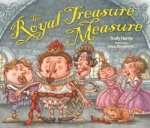
The Royal Treasure Measure
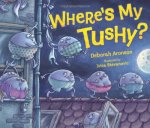
Where’s My Tushy?
.
Review HERE.

Filed under:
5stars,
Debut Author,
Favorites,
Library Donated Books,
Middle Grade,
Series Tagged:
Berenson Schemes series,
Caribbean Islands,
Darby Creek,
get-rich-quick schemes,
Ivica Stevanovic,
Jack Castaway,
Lerner Publishing Group,
Lisa Doan,
middle grade books,
reluctant readers,
whale shark 







By:
Sue Morris,
on 6/4/2014
Blog:
Kid Lit Reviews
(
Login to Add to MyJacketFlap)
JacketFlap tags:
bottoms,
Deborah Aronson,
Ivica Stevanovic,
tushes,
Children's Books,
Picture Book,
children's book reviews,
Debut Author,
Carolrhoda Books,
Lerner Publishing Group,
4stars,
Library Donated Books,
butts,
Add a tag
 Where’s My Tushy?
Where’s My Tushy? 
by Deborah Aronson & Ivica Stevanovic, illustrator
Carolrhoda Books 1/05/2014
978-1-4677-1197-5
Age 4 to 8 32 pages
.
“In one little town (it is sad but it’s true), the tushies left town without leaving a clue. What happens when all the tushies in an unusual town decide to take a vacation?”
Opening
“We all have a tush and we’re glad that we’ve got ‘em. Our lives would be rough with no tush or no bottom. If our tushies decided to get up and leave, we’d find it alarming and hard to believe”
Review
In an odd little English town, on a nice night, all the tushies decided they deserved a holiday from their tough, stressful lives. The townsfolk awoke shocked to have lost their tushie. They tried to go about their normal day, yet nothing held up their pants. Oh, they all tried. Some stuffed their vacant bottom with socks or pillows, while others used rope or suspenders. It was a sorry sight.
Now, stop laughing! These people couldn’t sit down without their tushie. Standing made their feet tired—would they too walk away? Some cried out for their tushie to return, but the earless, triangular tushies went south, to lounge around on the beach and soak up the sun. Detectives tried detecting. People hung posters. Police took reports. A dog and cat—with tushies—stared at a poster, alarmed at the sight of the smiling tush.
Without the pressure and stress normally felt, the tushies enjoyed each carefree day . . . until, like most on holiday, they begin missing home and their jobs—okay, not quite like most. One day, a young redheaded girl tripped on a lump of grass and fortuitously fell down on her rump. She was thrilled for her tush was once again behind her. One by one, the tushies returned to their bottoms, promising never to abandon their person again.
Loaded with laughs and guffaws, Where’s My Tushie will delight kids. Tushes young and old leave town wearing nothing but undies. They have faces complete with eyes, nose, mouth, and a crack that gives them two horizontal chins. They sprout feet and hands. One must suspend their beliefs to enjoy the story. Easily done. The story, told in rhyme, are made of fantastic couplets—some quatrains—that are fun to read aloud because Ms. Aronson never misses a beat.
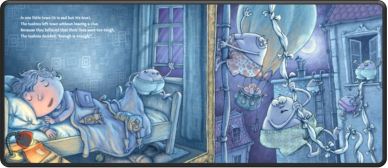
The illustrations are nicely done. I love the alarmed looks when all realize they have no tush. For one little boy, a dotted line outlines where his bottom should have been. I love all the detail and the little surprises in some of the spreads. Most have a tush or two looking on, smiling at the make shift behinds, as if enjoying the chaos they have caused. Two detectives, one with a magnifying glass, totally miss the double decker bus with a roof full of tushies. Sightseers, I’m sure.
Depending on a child’s age and gullibility, this inventive story will have kids checking for tushies, at least for a while. I am wondering where the tushies’ arms and legs went now that they have returned to being behinds. Do they fall off and regenerate when needed? I’m just as quizzical about the eyes, mouth, and nose. If the nose remains on the tush, eventually the promise never to leave will be broken. No doubt, kids will have thoughts such as those, and anyone who gets a solid answer, please let me know.
Teachers—inventive teachers—might find a use for Where’s My Tushie in the classroom. Young American kids will have questions about more than tushies. The illustrations are definitely English with a red double-decker and Sherlock Holmes like detectives, among other things. Don’t miss the hungry shark ready to eat a swimming tush. He possesses the crazed look seen in villainous cartoons.
WHERE’S MY TUSHIE. Text copyright © 2014 by Deborah Aronson. Illustrations copyright © 2014 by Ivica Stevanovic. Reproduced by permission of the publisher, Carolrhoda Books, Minneapolis, MN.
Buy Where’s My Tushie at Amazon —B&N—Lerner Books—your local bookstore.
—B&N—Lerner Books—your local bookstore.
Learn more about Where’s My Tushie HERE.
Meet the author, Deborah Aronson, at her bio: http://www.hermanagencyinc.com/deborah_aronson.htm
Meet the illustrator, Ivica Stevanovic, at her website: http://ivicastevanovicart.blogspot.com/
Meet Carolrhoda Books, an imprint of Lerner Publishing Group, at the company blog:
Also by Ivica Stevanovic
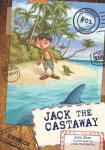
Jack the Castaway (The Berenson Schemes)
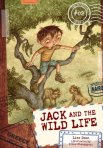
Jack and the Wild Life (Berenson Schemes)
.
.
Will be reviewing these soon!

Filed under:
4stars,
Children's Books,
Debut Author,
Library Donated Books,
Picture Book Tagged:
bottoms,
butts,
Carolrhoda Books,
children's book reviews,
Deborah Aronson,
Ivica Stevanovic,
Lerner Publishing Group,
tushes 







By:
Sue Morris,
on 5/29/2014
Blog:
Kid Lit Reviews
(
Login to Add to MyJacketFlap)
JacketFlap tags:
Children's Books,
Picture Book,
New Zealand,
children's book reviews,
dancing,
movement,
Sarah Davis,
Lerner Publishing Group,
4stars,
Juliette MacIver,
Library Donated Books,
Gecko Press USA,
toucans,
unusual animals,
Add a tag
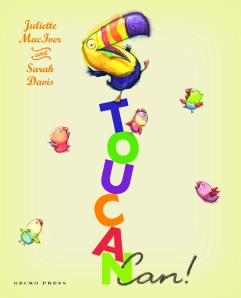 .
.
Toucan Can!
by Juliette MacIver & Sarah Davis, illustrator
Gecko Press USA 2014
978-1-877467-53-0
Age 3 to 7 32 pages
.
“Toucan Can Do Lots of Things! Toucan Dances! Toucan Sings! Toucan Bangs a Frying Pan! Can You Do What Toucan Can? A tongue-twisting, ludicrous rhyme full of escalating hilarity and off-the-wall characters. It will have you tripping and flipping and dancing and singing.”
If Toucan can, YOU can!
Opening
“Toucan can do lots of things!”
Review
What can you do? Toucan can do many things and might have toddlers showing off what they can do, too. Toucan and his group of goofy animal friends will have you and your child laughing. The rhyming text works in all but three couplets, where the beat goes bonk. Otherwise, the lines will roll off your tongue until your tongue is twisted. All this tongue-tying will add to the fun. With a couple run-throughs, you can have those lines sounding like Toucan can read, because Toucan Can!
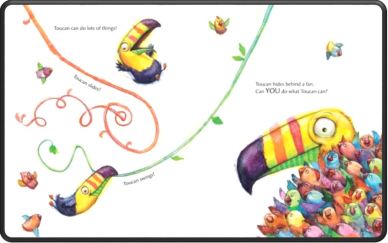
The illustrations have a high-end coloring book look, but with child-like coloring; meaning, as example, the purple of Toucan’s not very big bottom blotches beyond the border. Characters and background images consistently bleed. The illustrator’s technique or a printing problem? Curious and not wanting to criticize something I didn’t understand, I asked the illustrator. Here is what she wrote,
“The bleed is deliberate – for this book I wanted to find a style of working that was really loose and energetic, and the opposite of neat and precise. I hand painted tissue and then laid torn chunks of it down, then did the linework and detail on top. The idea with letting the colour bleed out around the edges is that there’s so much life and movement in the text that it can’t be contained. Toucan is such an irrepressible character that I didn’t want to colour him inside the lines – he needed some chaos.”

Every character, on every spread, is moving. “Happy Chaos” is a good description of the spreads, as the animals swing from trees, twirl, and dance. An exception to the merriment is a joey in mama’s pouch. I fear Toucan might have awakened the joey from its snug pouch. It takes only a minute—one spread—to soften the joey’s slanted eyebrows and rolled up fists. Mama’s energy is still passing to her baby.
The text is fun to read a-loud and young children will enjoy hearing all Toucan can do. When asked if “you” can do what Toucan can, young children will be out of their seat bopping about, jumping, skipping, and singing, but mainly dancing. All the animals love to dance and they all dance with exuberance. Very contagious.
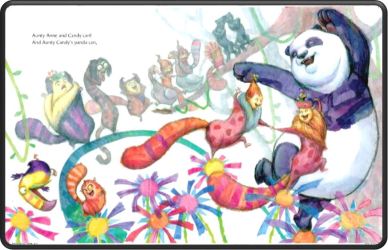
Originally published by Gecko Press in New Zealand, Lerner Publishing Group brings Toucan Can to the US and Canada. Toucan Can has hilarious images, interactive suggestions to keep young kids moving and laughing. The rhyming text and tongue twisters will keep the reader—mom or dad—determined to get it right, making Toucan Can a book young kids will have no trouble getting their parents to read over and over.
TOUCAN CAN! Text copyright © 2013 by Juliette MacIver. Illustrations copyright © 2013 by Sarah Davis. Reproduce by permission of the publisher, Gecko Press USA, Wellington, NZ.
Buy Toucan Can! at Amazon —B&N—Lerner Pub. Gr.—your local bookstore.
—B&N—Lerner Pub. Gr.—your local bookstore.
.
Learn more about Toucan Can! HERE.
Meet the author, Juliette MacIver, at her facebook: https://www.facebook.com/pages/Juliette-MacIver-Author/509684365718086
Meet the illustrator, Sarah Davis, at her website: http://sarah-davis.org/
“For more curiously good books visit” Gecko Press: http://www.geckopress.co.nz/
an imprint of Gecko Press Ltd.
distributed by Lerner Publishing Group: https://www.lernerbooks.com/
Also by Juliette MacIver
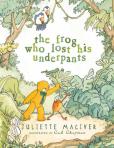
The Frog Who Lost His Underpants
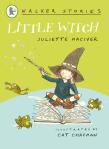
Little Witch Walker Stories
Also by Sarah Davis
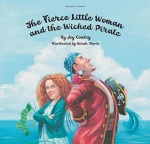
The Fierce Little Woman and the Wicked Pirate

The Bicycle
.
.

Filed under:
4stars,
Children's Books,
Library Donated Books,
Picture Book Tagged:
children's book reviews,
dancing,
Gecko Press USA,
Juliette MacIver,
Lerner Publishing Group,
movement,
New Zealand,
Sarah Davis,
toucans,
unusual animals 







Lest we grow complacent in our maternity leave, I’ve quite a few librarian previews just ah-waiting postings. And what better way to begin than with Lerner Books here? Everyone’s favorite Minnesotan publisher came to town in the guise of Lindsay Matvick. We ate pizza. We talked shop. We heard about what Lerner has on offer and what we can expect this coming fall. So hold on to your hats, folks. This is one of those previews that just get better and better the deeper you go.
First off . . .
Why Is the Statue of Liberty Green? by Martha E.H. Rustad
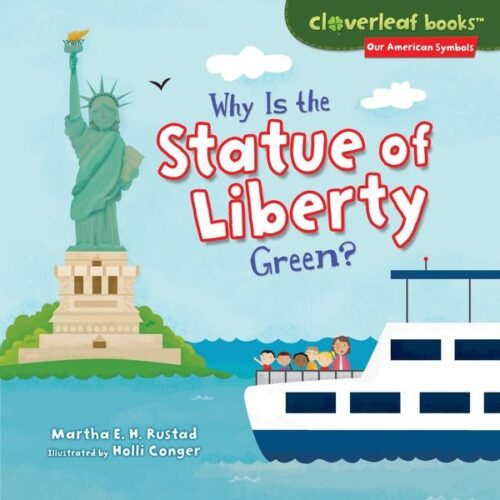
Good old, Cloverleaf Books. The faithful series on nonfiction topics we do indeed get questions about. In this particular case we’re discussing the “Our American Symbols” series. Covering everything from the Lincoln Memorial to The Star-Spangled Banner, the books cover the basics (“Why are there stripes on the American Flag?”, etc.) and then fill their rears with backmatter (there’s gotta be a better way of saying that). In the case of the flag, for example, there are projects for students on how to design your own flag. That sort of stuff. Keen.
Helper Robots by Nancy Furstinger
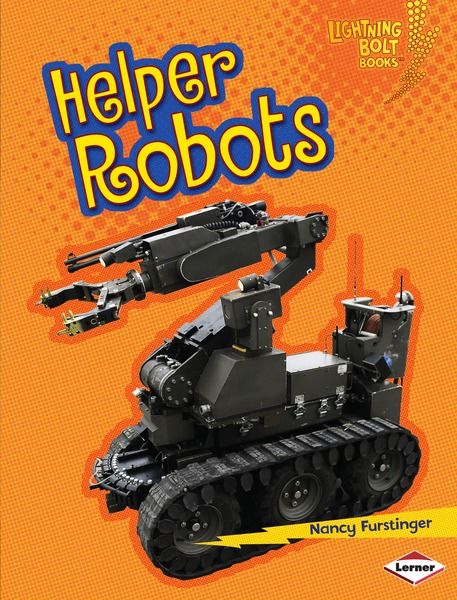
I took one look at this cover and thought to myself, “Help me do what exactly?” This is one of the books in the “Robots Everywhere!” series, coming out with Lightning Bolt Books. It’s not the first robot series out there, but it may well be the first one that gets any kind of reviews. Each book covers different types of real world robots. Robots you use in the home, robots you use in space, robots that help us with the weather, etc. Turns out the robot on the cover of this particular book is a robot that diffuses bombs. Okay. That’s something I might actually need help with.
What Are Nonfiction Genres? by Valerie Bodden

Awwwwww, yeah. Kicking it back literary genre style. So this would be the “Name That Text Type” series, and it’s pretty self-explanatory, all things considered. Each book tackles a different genre with written examples of the text type and guidelines on how to write in that particular genre. I picked the Nonfiction Genre book as the one to present here because I like the genre types included: Persuasive, Memoir, How-To, and Biography. We CERTAINLY get those requests in the library. Particularly the “How-To”. More on that later.
What’s So Great About New York? by Ann Malaspina
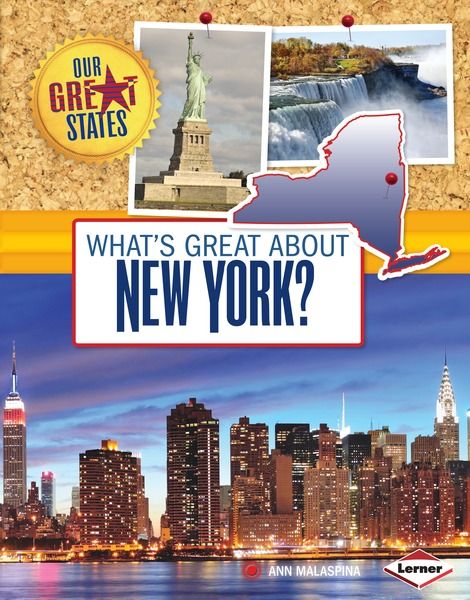
In spite of what it might look like, this isn’t yet another state book series. Each title is about a state, sure, but unlike the Enchantment With the World books, or their equivalents, these books take a travel guide approach. Each one discusses what there is to actually DO in the states in question. Which, let’s face it, could be really useful for some kids. The series also uses infographics and will highlight Puerto Rico and Washington D.C. in addition to the usual 50 states. It’s called the “Our Great States” series and there will be eighteen to begin this season.
Finding Out About Nuclear Energy by Matt Doeden

Two Words: Opposing. Viewpoints. You and I both know that in the world of CCSS, those little words carry a great big weight. Finding books that actually contain said opposing viewpoints can also be tricky. In this series (the “What Are Energy Sources?” series) kids read about the pros and cons about everything from Hydropower and Solar energy to Geothermal and Coal, Oil, and Natural Gas. The series covers what companies want to do vs. what the government wants them to do. We got into a whole discussion of BISAC codes at this point and how one would go about putting information about opposing viewpoints into the records when we got to this series. Librarian shop talk. It’s all the rage.
Economics Through Infographics by Karen Latchana Kenney
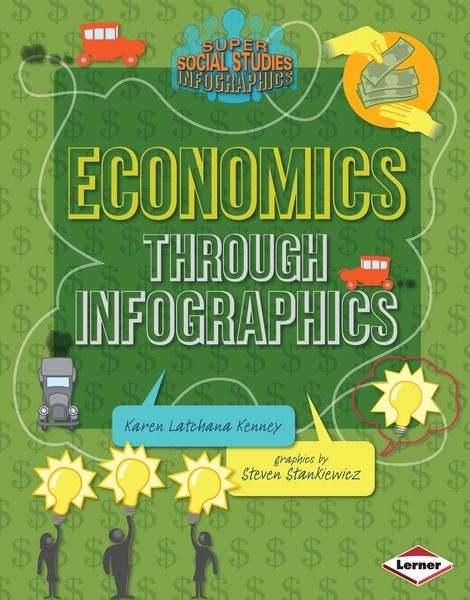
For this “Super Social Studies Infographics” series I could have gone with US History or World Geography as various topics, but I suspect that Economics appealed to me the most because that’s the book that I myself would want to read. Having already done the “Super Science Infographics” series, Lerner wanted to tackle some of the trickier topics in the social studies world. So expect lots of geography and history.
Your Head Shape Reveals Your Personality by Christine Zuchora-Walske
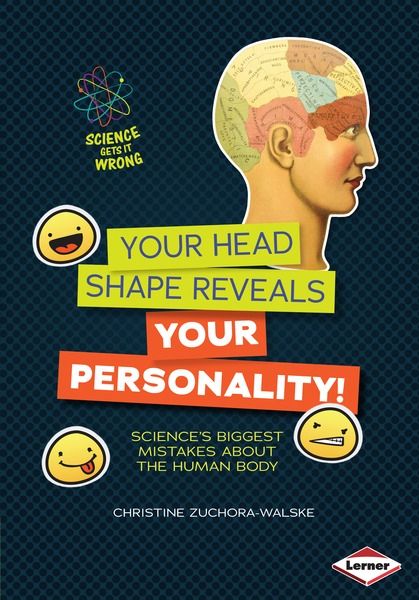
This would be the “Science Gets It Wrong” series. To make their case, the books build on the scientific method to cover everything from whether or not your handwriting can predict your personality (spoiler alert: it can’t) to whether or not bulls get mad when they see the color red (they don’t). They’re myth busting books. Best of all the books show that science is not just black and white and it certainly isn’t always right.
Plan a Sleepover Party by Stephanie Watson

Remember the What Are Nonfiction Genres? book when I was cooing over its discussion of How To books? Well, consider this a full-fledged How To series. “Party Time”, for so the series is called, show kids how to host everything from a birthday or outdoor party to a holiday or sleepover shindig. I wondered at first if they’d be read more by adults than kids, but they’ve certainly got some good kid-friendly elements to them. Recipes that kids could actually do. Sample playlists. So there you go.
Playing Pro Basketball by Martin Gitlin
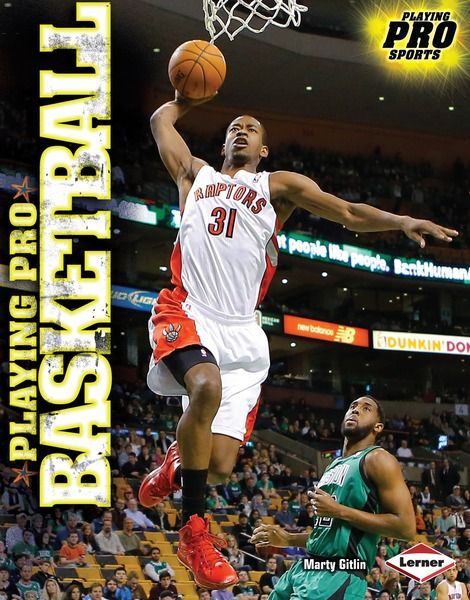
Lots of kids play with the notion of what it would be like to be a famous sports star. But this “Playing Pro Sports” series is the first I’ve seen that covers what that would actually entail. From training to diets to superstitions and interviews, it’s actually a good job skills book. And lord knows we can’t keep our job opportunity titles on the shelves. They’re saying this is for grades 4-8, and each was vetted by former pro athletes. So far they just cover football, basketball, baseball, and hockey. I have my fingers crossed for WNBA one of these days.
Movies and TV Top Tens by Sandy Donovan

Let’s say you wanted to make a series that could take on a certain aspect of The Guinness Book of World Records in some fashion. One method might be to do what the “Entertainment’s Top 10″ series is trying here. Each book covers different top ten lists in a different area of the entertainment industry. So you’ve got music and theater, sports, technology, and movies and TV. Based on facts with verifiable data, the books are loaded with history too, apparently.
A Timeline History of Early American Indian Peoples by Diane Marczely Gimpel
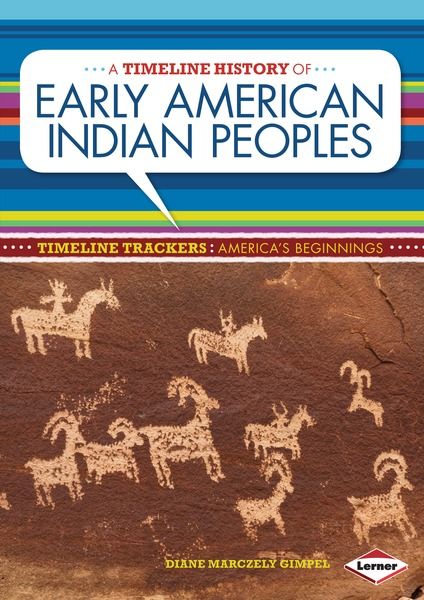
This year I’ve been having a heckuva time with a big chunk of the biographies being written for kids. Because you know what a lot of schools require that these books eschew? Timelines. Sometimes it feels like no one cares about timelines anymore. Well, in the “Timeline Trackers” series, we get to see history in a big old line. Loads of primary sources are on these pages (another CCSS requirement) and I was much intrigued by the first volume which focuses entirely on Early American Indian Peoples and nothing else. About bloody time too.
Get a Job Making Stuff to Sell by Ryan Jacobson
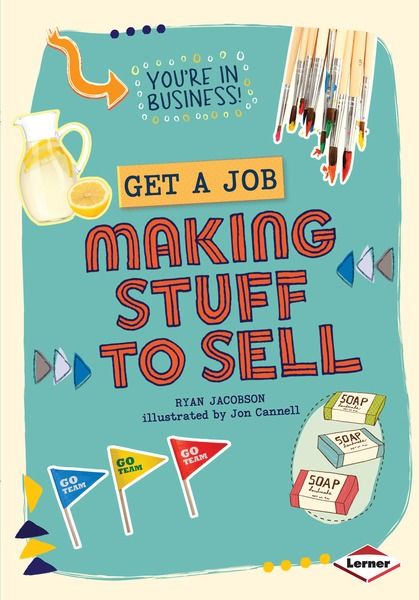
I always feel a bit bad for kids who want to make money these days. Lemonade stands will only get you so far and paper routes are going the way of the dinosaur. Add in the fact that I live in a city where serious faced ten-year-olds would approach my reference desk asking for books about Wall Street and this series will find a happy home here. It’s the “You’re in Business” series and it’s for kids under the age of 16 who want jobs. Entrepreneurs, if you will. Covering everything from making homemade soap to crafting cell phone covers, the books also give you information on how to fill out a job application, and things like that.
The Case of the Vanishing Little Brown Bats by Sandra Markle
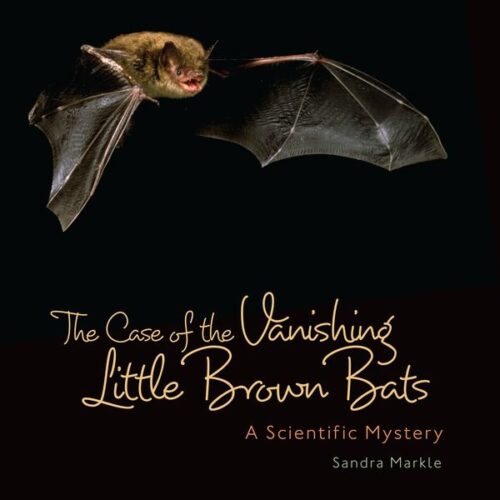
You thrilled to The Case of the Vanishing Golden Frogs. You were awed by The Case of the Vanishing Honeybees. Now it’s time to learn about “white nose syndrome”, which sounds like a disease out of a horror film more than anything else. Bats, as it happens, are integral to our ecosystem and this book shows what scientists are currently doing to save those little brown bats that are disappearing like mad. Bees get all the attention, but bats are just as important.
When Lunch Fights Back: Wickedly Clever Animal Defenses by Rebecca L. Johnson

Remember Zombie Makers? The book that was guaranteed to give you nightmares as it systematically cataloged the parasites, insects, molds and more that were capable of turning living organisms into zombies? Well, author Rebecca L. Johnson is back and she brought along some defense mechanisms. Not for the squeamish, this book shows that sometimes the key to survival can be pretty darn weird. Meet frogs that poke their bones through their skin to make claws and termites that blow themselves up for the greater good. Great photographs too, though you may not want to look at them right after eating.
Ghost Walls by Sally M. Walker
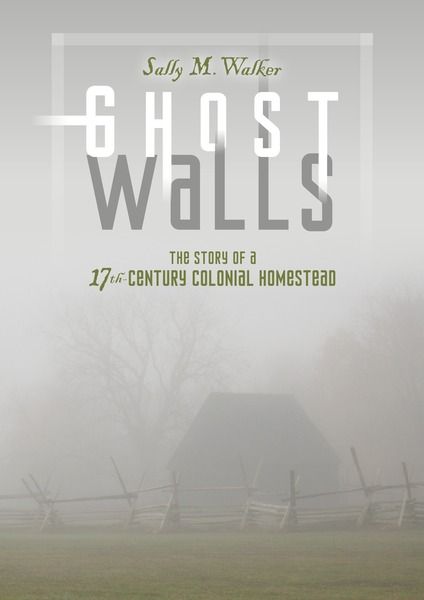
One thing I like about the Lerner info sheets is that they take a special amount of time to include the Dewey Decimal Numbers with their books. This one? 975. Sally Walker has been behind books like Written in Bone: Buried Lives of Jamestown and Colonial Maryland so digging up the past is nothing new to her. In the case of this particular book, Sally concentrates on a building that sat silent for two centuries. In its day the homestead was privy to a range of different travelers and stories. Now researchers are going back to it to unlock its secrets. Or, as the book puts it, “coaxing history from the crumbling walls.”
Ghostly Evidence: Exploring the Paranormal by Kelly Milner Halls

Librarians, back me up on this one. When it comes to middle grade nonfiction about ghosts we have next to nothing to offer. So when I saw this book by the woman who brought us books on Sasquatch and aliens, I knew we were onto something good. With a great deal of fun research, Halls gives us the science behind “the hunt”. Ghost hunt, that is. The book takes a scientific approach and includes lots of interviews with firsthand accounts. It’s not just stories, though. There’s also lots of backmatter and even a listing of haunted places to visit. Now THERE’S a summer vacation trip worth recounting!
Arctic Thaw by Stephanie Sammartino McPherson

We’re getting into the middle school and YA titles now, which I usually eschew. But these are so friggin’ cool I couldn’t help but include them! First off, this little puppy. There are lots of climate change books out there. Now how many can you think of off the top of your head that discuss the shipping lanes that are now opening up thanks to our warming world? This book examines the indigenous groups, countries, and companies all vying for this space. The book also focuses on what is happening and what should be done, though it avoids becoming overtly political.
Chernobyl’s Wild Kingdom by Rebecca L. Johnson
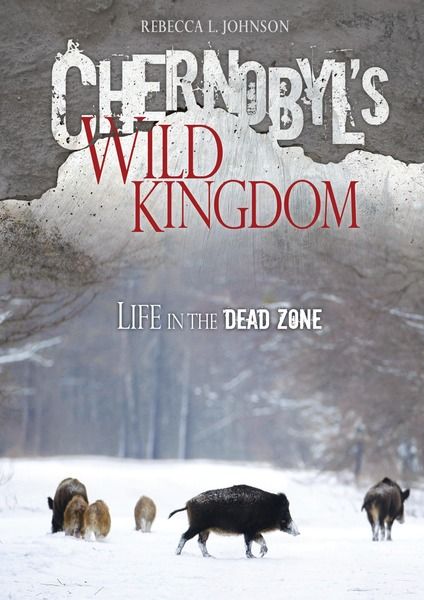
If you’ve been watching the news stories then you probably know already that it’s been twenty-five years since the 1986 Chernobyl nuclear disaster. The area was turned into a 1,100 square mile Exclusion Zone and no humans can live there. But animals? Thanks to the lack of humans the place has turned back into its natural state. And what’s weird is that the animals appear to be surviving just fine in the radiation. Consider this as a brilliant nonfiction tie-in to all that dystopian fiction out there. You want to see a post-apocalyptic world for yourself? Behold.
Fad Mania! by Cynthia Overbeck Bix
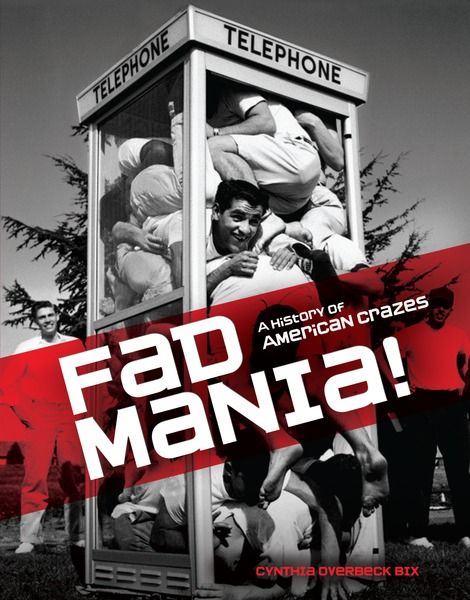
Tell me that isn’t one of the greatest covers of all time. Plus this is such a good idea for a book. The title discusses different American fads as they have appeared over the last few years. Everything from old timey fads like dance marathons to current ones like flash mobs. Basically the book works to put current fads in perspective. It examines when fads increase and the role of economics. Plus, with the rise of the internet we’re seeing more and more of them.
Girls vs. Guys by Michael J. Rosen

“Developmental plasticity”. Say it soft and it’s almost like praying. That’s the buzzword (buzzphrase?) I took away with me when I learned about this book. Called the YA take on Men Are From Mars, Women Are From Venus, the book looks at the differences between the genders. Written in a Q&A format, it examines how environment, nutrition, sleep, and sensory stimulation shape your personality. And for the record, “developmental plasticity” refers to “the way that environment and experience can entwine to alter genetically determined gender behavior.” Learn something new every day, doncha?
Remaking the John by Francesca Davis DiPiazza

Fun Fact: November 19th is World Toilet Day. Put it on your calendar right now, and I’ll wait to continue until you are done. Okay, ready? So in this book we get all the poop on poop (which is a line from a different poop-related book for kids). Telling us that as of right now 40% of the world’s population doesn’t have proper sanitation, the book ropes the global sanitation crises into a look at the history of human waste. You get the down low on what it was like in the past, as well as what it’s like for some folks today. Best of all, it mentioned that the Bill & Melinda Gates Foundation had a challenge to Reinvent the Toilet for those nations and communities that need ‘em.
Saturday Night Live by Arie Kaplan
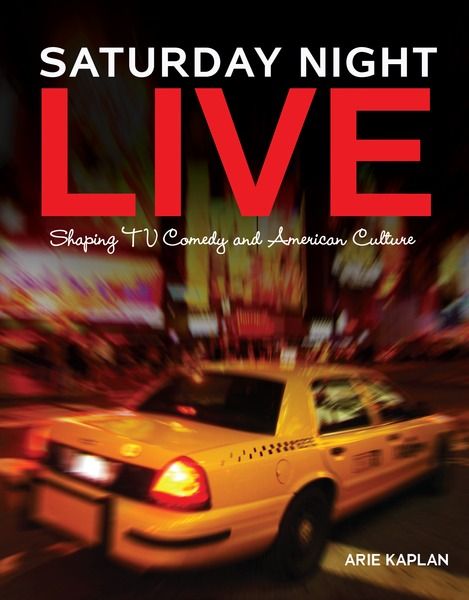
Now there’s a thought. Teens like TV. Why not take something with history, like Saturday Night Live, and give kids the 411 on it? Coming out in tandem with the 40th anniversary of the show, the book covers the highs, lows, and controversies of the last-night comedy show.
Transgender Lives by Kirstin Cronn-Mills
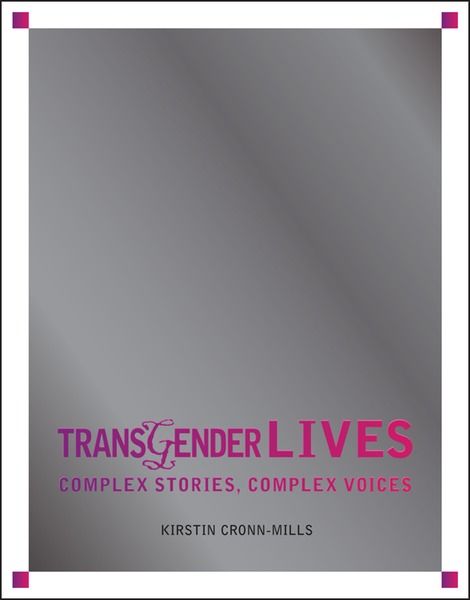
First off, you can’t really get the cover from this image. It’s reflective foil that, when you look at it, shows your own face. Cool, right? Well, since the publication of Susan Kuklin’s Beyond Magenta, we’ve started seeing an increased comfort in YA fare on the transgendered. In this particular case, author Kirstin Cronn-Mills was working on this for quite a few years. The book introduces seven different people, discussing their lives and stories.
Up for Sale by Alison Marie Behnke

Probably the toughest book on the list. As you can see, it’s a book on contemporary human trafficking, but not a single kind of trafficking situation. No, it hits on all the different aspects of trafficking, even the human organ trade. At the same time author Behnke talks readers through the legal reforms and advocacy being done on behalf of the victims. Since a significant number of people trafficked are teens, this makes for a perfect YA nonfiction tie-in.
Sometimes You Barf by Nancy Carlson

“Here’s the deal: Sometimes you barf . . . But it’s okay. You get better!” For kids that have barfed in public, there’s really not a book for their plight. Nancy Carlson has therefore managed to come up with a topic that everyone needs in their libraries but that, to the best of my knowledge, no one has ever asked for before. Excellent.
Santa Clauses by Bob Raczka
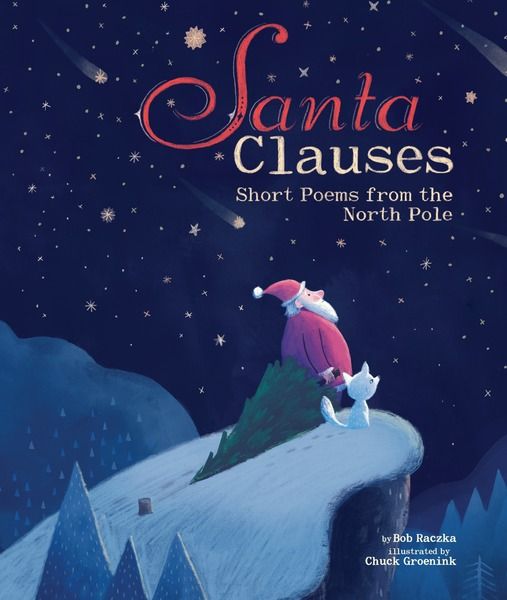
Think of it as a literary advent calendar. Starting with December 1st, the book systematically does one poem for each day, counting down to Christmas itself. The poems themselves are haikus (this is Bob Raczka we’re talking about, after all) and the art by Chuck Groenink is really rather remarkable. I don’t know how nobody thought of this before, but I’m happy it’s finally going to happen.
Dear Wandering Wildebeest by Irene Latham

More poetry, thank goodness. Not like we see a bunch of it in a given year. In this book the entire ecosystem of a watering hole is looked at with poetry and facts. The poetry yields poems with titles like “Triptych for a Thirsty Giraffe”. The facts discuss what’s actually going on in each spread.
Who Was Here? by Mia Posada
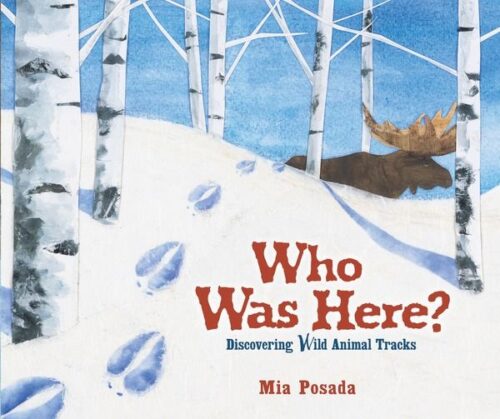
Here in New York we don’t get much call for teaching our kids about animal tracks. In other parts of the country, though, it’s a given. In this book, all the prints are rendered in actual size. From camels to moose to kangaroos, you get a global look at animal tracks from all over the world.
BirdCatDog by Lee Nordling
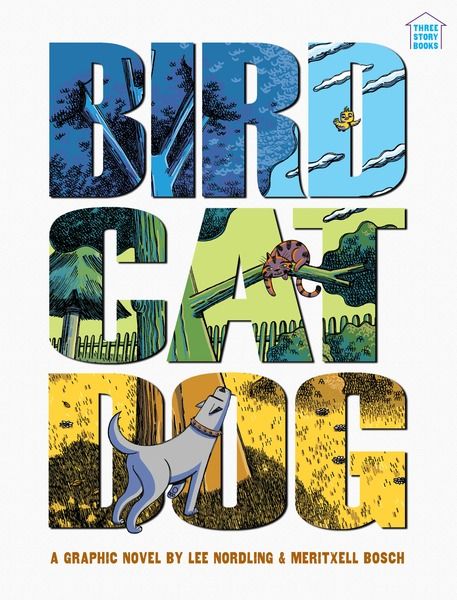
If poetry is rare this year then comics are even rarer. So imagine my relief when I saw this graphic novel. A wordless graphic novel at that. Each page allows you to read the three stories (of the bird, cat, and dog) together or separately, as you prefer. I don’t know this Meritxell Bosch of which they speak. All I know is that in my next life I want to come back as someone named Meritxell. If there’s a cooler first name out there, I haven’t heard of it.
I Remember Beirut by Zeina Abirached

If anyone remembers A Game of Swallows, then they should be mighty excited to read this follow-up to the award winning book. Born in Lebanon in 1981, A Game of Swallows chronicled one family’s escape. In this prequel of sorts, you see what was going on outside the walls of their home. Lots of little details are included, like Zeina going out to collect shrapnel with her brother for fun.
Fat & Bones by Larissa Theule
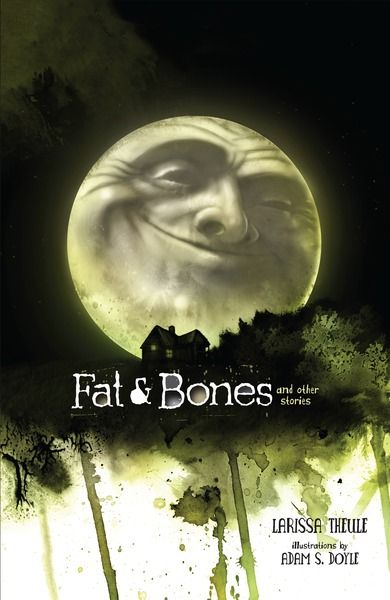
I’ve actually read this one! Partly just to see whether or not it really is YA or if it could fit in a middle grade library. And after reading it . . . yeah, I guess YA is the right place for it. It’s not that the content is anything too terrible. It’s just a mature little book. A middle school library could probably hold onto it without difficulty. Told as slightly supernatural short stories, the book makes for a fun quick read. The art brings to mind Stephen Gammell and his Scary Stories to Tell in the Dark. Seems to me Adam S. Doyle was the guy they should have called when they had those puppies re-illustrated.
Knockout Games by G. Neri

Finally, we have ourselves a G. Neri. I wish he’d do more middle grade, but since he has a picture book coming out this year (a bio of Johnny Cash, no less) I guess I can’t complain. This book plays off of that relatively recent news story about teen randomly knocking out strangers in something they call “knockout games”. But the games aren’t new and Neri’s been working on this book for years. Heck, in the back of the book there’s even a note from a St. Louis librarian attesting to the validity of this story. In this tale a girl would be filmmaker is contacted by the leader of a gang. He wants her to film his exploits and as she does the book takes on a kind of Man Bites Dog turn. Definitely YA.
And that’s all she wrote! Thanks to Lindsay and the good folks at Lerner for giving me a peek at the wares. Cheers!

By:
Sue Morris,
on 5/26/2014
Blog:
Kid Lit Reviews
(
Login to Add to MyJacketFlap)
JacketFlap tags:
children's book reviews,
Laura Purdie Salas,
Millbrook Press,
water,
Lerner Publishing Group,
5stars,
Violeta Dabija,
Library Donated Books,
forms of water,
water properties,
Children's Books,
Picture Book,
poetry,
Favorites,
Add a tag
 .
.
Water Can Be . . . 
by Laura Purdie Salas & Violeta Dabija, illustrator
MillBrook Press 4/01/2014
978-1-4677-0591-2
Age 4 to 8 32 pages
.
“Water can be a . . . Thirst quencher. Kid drencher. Cloud fluffer. Fire snuffer. Find out about the many roles water pays in this poetic exploration of water throughout the year.”
Opening
“Water us water—
it’s puddle, pond sea.
When springtime comes splashing,
the water flows free.”
Review
Water Can Be . . . is the second Laura Purdie Salas picture book reviewed here at KLR. The first was A Leaf Can Be . . . (reviewed here) which is about all the things a leaf can be that we never think about or realized. In that same vain, Water Can Be . . . is about all the things we may not notice about water. Told in rhyming text, the story needs the illustrations, as the two together make the wonderful story of what Water Can Be . . .
There are a few things that water can become that I had not thought of. We all know that snow is water, rain is water, and my personal favorite, ice is water. Have you ever heard of a “woodchuck warmer?” Did you know that water heavily influences the woodchuck warmer? Me either. I had no idea what a woodchuck warmer is, or that water was involved, and honestly, the illustrations failed me on this. It looks like an animal sleeping under a blanket of leaves.
In the back of the book, the author wrote a guide to each thing water could be. Thanks to that guide, I can explain how a woodchuck warmer and water influence each other. Woodchucks burrow in the ground and hibernate. If not for the snowfall atop the leaves that lay upon the burrow opening, and across the land above the burrow, these winter homes would become tragically cold and the woodchucks would most likely not survive the winter. Water, now in the form of snow, acts as an insulator. That is one heck of a job for water and it works wondrously.

The illustrations are gorgeous, just as they were in A Leaf Can Be . . . but the author presents the water possibilities in a scattered manner. Spreads jump from a light image, say of two kids playing in a water sprinkler or fluffer clouds, to a ship at trouble in a storm or a firefighters putting out a forest fire, as birds quickly fly away, sometimes in the same spread. Most images are in shades of bluish-green, some darker than others. My favorite illustration is water as a picture catcher. A young girl looks at herself in the smooth surface of a little pond and sees a reflection of herself. The illustration is fantastic. I love that the facial expressions are nearly identical and the nice shade of red in the girl’s coat.
Each thing water can become is beautifully visualized so kids can instantly understand the two-word concepts presented, such as thirst quencher / kid drencher and home maker / ship breaker. Younger children will grasp most of the possibilities. Heck, even an adult can understand what water can be . . . well, maybe not all of the concepts.
Water Can Be . . . is a home and school library keeper. In schools, it is useful for teaching younger children about the elements—beginning with water—in its many forms, performing many life-affirming tasks. There are more uses than what Water Can Be . . . rhythmically covered. The author challenges the reader to find more on his or her own. What do you think Water Can Be . . .?
WATER CAN BE . . . Text copyright © 2014 by Laura Purdie Salas. Illustrations copyright © 2014 by Violeta Dabija. Reproduced by permission of the publisher, Millbrook Press, Minneapolis, MN.
Get a copy of Water Can Be . . . at Amazon —B&N—Lerner Publishing—your local bookstore.
—B&N—Lerner Publishing—your local bookstore.
*10% of author’s revenue is donated to WaterAid.org
.
Learn more about Water Can Be . . . HERE.
Meet the author, Laura Purdie Salas, at her website: http://www.laurasalas.com/
Meet the illustrator, Violeta Dabija, at her website: http://www.violetadabija.com/
Find books at the Millbrook Press website:
an imprint of Lerner Publishing Group: https://www.lernerbooks.com/
.
Also by Laura Purdie Salas

A Fuzzy-Fast Blur: Poems about Pets
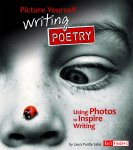
Picture Yourself Writing Poetry: Using Photos to Inspire Writing (See It, Write It)
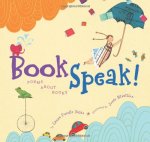
BookSpeak!: Poems About Books
Also by Violeta Dabija

Nach Regen kommt Sonne und andere Bärengeschichten (After rain comes sun bears and other stories)
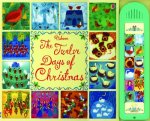
The Twelve Days of Christmas
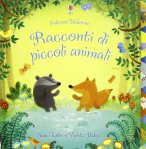
Racconti di piccoli animali. Racconti per la nanna (Stories of small animals. Stories for Bedtime)
.
.

Filed under:
5stars,
Children's Books,
Favorites,
Library Donated Books,
Picture Book Tagged:
children's book reviews,
forms of water,
Laura Purdie Salas,
Lerner Publishing Group,
Millbrook Press,
poetry,
Violeta Dabija,
water,
water properties 







By:
Sue Morris,
on 5/8/2014
Blog:
Kid Lit Reviews
(
Login to Add to MyJacketFlap)
JacketFlap tags:
suffix,
Lerner Publishing Group,
Words are CATegorical,
5stars,
Library Donated Books,
Martin Goneau,
languge arts,
Children's Books,
Picture Book,
Poetry,
NonFiction,
Series,
children's book reviews,
Millbrook Press,
Brian P. Cleary,
Add a tag
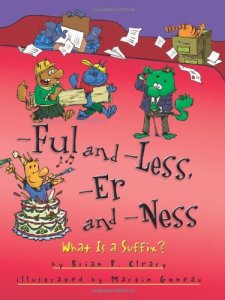 .
.
—full and —less, —er and —ness: What is a Suffix? (Words Are Categorical)
by Brian P. Cleary & Martin Goneau, illustrator
Millbrook Press
978-1-4677-0610-0
Age 32 pages
“A good paper, poem, or book isn’t written, it’s rewritten.” ~ Brian P. Cleary
“What is a Suffix? You’ll find the answer inside this book—it’s overflowing with wonderful suffixes. Brian P. Cleary’s playful rhymes and Martin Goneau’s humorous illustrations creatively present the concept of suffixes for young readers. For easy identification, key suffixes appear in color, and the comical cats reinforce each idea. —full and —less, —er and —ness: What is a Suffix turns traditional grammar lessons on end! Read and reread this book aloud and delight in the sense—and nonsense—of words.”
Opening
“Suffixes are word parts that are tacked on to a word. You’ll find a suffix at the end of farmer and preferred.”
Review
—full and —less, —er and —ness: What is a Suffix is one book of many in Cleary’s series Words are CATegorical. Kids will learn and have fun reading this funny book with the funniest illustrations. They will understand suffixes, and the probability of remembering what they learned increases with each rhyming sentence.
What is suffix? A suffix changes the meaning of the root word. In this edition of Words are CATegorical, Cleary used the four title suffixes and engaging rhyming sentences that kids will understand almost immediately.
“The E-R part of farmer speaks of someone who is doing, like the baker who is baking or the viewer who is viewing.”
Adding crazy illustrations of cats dressed as chefs and decorating cakes—one a disaster—while a third cat waits to eat the finished confection, helps kids remember what the suffix —er adds to a word with their sense of sight. The more senses that are involved, the easier it is to remember the information.
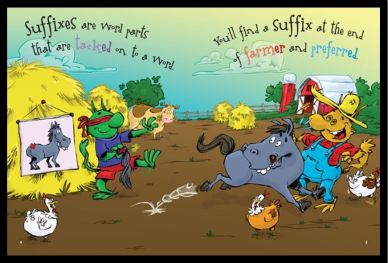
I doubt anyone could have done a better job with suffixes than Cleary and Goneau. Brian Cleary’s writing is a gift. He understands the best way to teach kids and have them truly understand and remember the concept. That would explain the success of not only this series, but nearly everything Cleary has written. Goneau’s illustrations comically present the concept so kids can actually see the suffix at work.
Homeschooling moms and dads need the Words are CATegorical series. The English language, being a difficult language to learn, comes alive in What is a Suffix? One read through and you will understand the mastery Cleary has over the English language and his ability to explain its concepts so kids can understand and remember by book’s end. It makes sense that school libraries should invest in this series. Kids having trouble grasping a language arts concept in class can read the applicable book, from the 25 thus far in the series, adding one more approach to teaching the English language. Sometimes with a new approach, kids get it and Cleary’s approach is most assuredly an “I get it” approach.
.
—FULL AND —LESS, —ER AND —NESS: WHAT IS A SUFFIX? Text copyright © 2014 by Brian P. Cleary. Illustrations copyright © 2014 by Martin Goneau. Reproduced by permission of the publisher, Millbrook Press, Minneapolis, MN.
.
Learn more about the series Words are CATegorical HERE.
Get your copy of What is a Suffix, or any of the 25 books in the series at Amazon —B&N—Millbrook Press—your local bookstore.
—B&N—Millbrook Press—your local bookstore.
.
Meet the author Brian P. Cleary at his website: http://www.brianpcleary.com/
Meet he illustrator, Martin Goneau, at his website: http://www.goneau.com/
Follow at the Millbrook Press facebook: https://www.facebook.com/millbrookpress
Millbrook Press is a division of Lerner Publishing Group
.
Also by Brian P. Cleary

The Bug in the Jug Wants a Hug
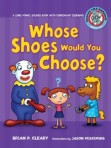
Whose Shoes Would You Choose?
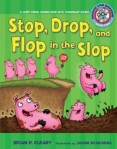
Stop, Drop, and Flop in the Slop
.
.
.
.
.
Also by Brian P. Cleary & Martin Goneau
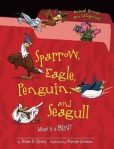
Sparrow, Eagle, Penguin, and Seagull: What Is a Bird?
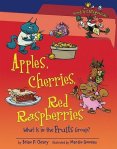
Apples, Cherries, Red Raspberries: What Is in the Fruits Group
.
.

Filed under:
5stars,
Children's Books,
Library Donated Books,
NonFiction,
Picture Book,
Poetry,
Series Tagged:
Brian P. Cleary,
children's book reviews,
languge arts,
Lerner Publishing Group,
Martin Goneau,
Millbrook Press,
suffix,
Words are CATegorical 







 Sometimes you just want to get your hands on some reliable nonfiction. The other day I was in the office and we’d spread out the vast quantities of nonfiction samples we’d been sent from a variety of publishers (all of whom shall remain nameless). And while some things were okay and other things were tolerable, so little of it was of the “Wow! Awesome!” variety. It would be disheartening if we didn’t have folks like Lerner to fall back on. And I’m not saying this to be all chummy with them. I honest-to-goodness really like their books. Are all Lerner books created equal? Of course not! But they fill gaps in my collection while at the same time providing books on subjects it would never have occurred to me to buy. And it tends to be reliable.
Sometimes you just want to get your hands on some reliable nonfiction. The other day I was in the office and we’d spread out the vast quantities of nonfiction samples we’d been sent from a variety of publishers (all of whom shall remain nameless). And while some things were okay and other things were tolerable, so little of it was of the “Wow! Awesome!” variety. It would be disheartening if we didn’t have folks like Lerner to fall back on. And I’m not saying this to be all chummy with them. I honest-to-goodness really like their books. Are all Lerner books created equal? Of course not! But they fill gaps in my collection while at the same time providing books on subjects it would never have occurred to me to buy. And it tends to be reliable.
So! With that in mind, here’s how the Spring ’14 season is looking for ole Lerner Books these days.
 First up, the Lightning Bolt Books series and their latest topic: “Animals in Danger”. We’re talking Endangered and Extinct Bird, Endangered and Extinct Mammals, even Endangered and Extinct Invertebrates. The lure is that a lot of these contain a heartening comeback story at the end of each book of some animal or critter that nearly went belly-up and then was saved at the last minute. I know plenty of kids that have to do endangered animal units for school, so it seems to me this makes for a much needed topic and category.
First up, the Lightning Bolt Books series and their latest topic: “Animals in Danger”. We’re talking Endangered and Extinct Bird, Endangered and Extinct Mammals, even Endangered and Extinct Invertebrates. The lure is that a lot of these contain a heartening comeback story at the end of each book of some animal or critter that nearly went belly-up and then was saved at the last minute. I know plenty of kids that have to do endangered animal units for school, so it seems to me this makes for a much needed topic and category.
 Speaking of requests I hear a lot, this is one that I wish to high heaven would go away and yet it never will. I’m talking about “character building” books. Books that by dint of even being read will miraculously transform your child into a better person through their cheery texts. Terrible, horrible, no good, very bad books of this ilk are assigned to children every day in schools. So while I loathe and abhor them, I am infinitely grateful to Lerner for at least doing a couple decent ones on the topics we’re used to being asked for. Case in point, the “Show Your Character” series. They’re multicultural and act as a slightly older version of Stuart J. Murphy’s “The Way I Act” series.
Speaking of requests I hear a lot, this is one that I wish to high heaven would go away and yet it never will. I’m talking about “character building” books. Books that by dint of even being read will miraculously transform your child into a better person through their cheery texts. Terrible, horrible, no good, very bad books of this ilk are assigned to children every day in schools. So while I loathe and abhor them, I am infinitely grateful to Lerner for at least doing a couple decent ones on the topics we’re used to being asked for. Case in point, the “Show Your Character” series. They’re multicultural and act as a slightly older version of Stuart J. Murphy’s “The Way I Act” series.
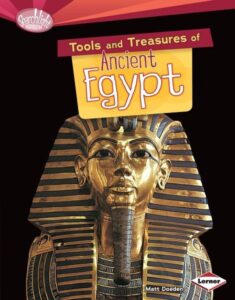 So here’s the deal with Common Core. I’ve nothing against it myself. Just the way it’s implemented some of the time. But even as I say that, there are aspects to CCSS that are difficult to deal with. I’m thinking in particular of the areas that are required and need written material, but where there’s very little in the marketplace. Particularly in the case of early civilizations. Second and third graders are supposed to be learning about China or Mesopotamia, but where the heck is the series written at an earlier reading level? Meet the new Searchlight Books series “What Can We Learn from Early Civilizations?” Each book is written on a easier level than a lot of books out there, and they cover everything from how these civilizations influence us today to folklore beliefs associated with those civilizations. Plus anything that touches on Ancient Egypt is all good with me.
So here’s the deal with Common Core. I’ve nothing against it myself. Just the way it’s implemented some of the time. But even as I say that, there are aspects to CCSS that are difficult to deal with. I’m thinking in particular of the areas that are required and need written material, but where there’s very little in the marketplace. Particularly in the case of early civilizations. Second and third graders are supposed to be learning about China or Mesopotamia, but where the heck is the series written at an earlier reading level? Meet the new Searchlight Books series “What Can We Learn from Early Civilizations?” Each book is written on a easier level than a lot of books out there, and they cover everything from how these civilizations influence us today to folklore beliefs associated with those civilizations. Plus anything that touches on Ancient Egypt is all good with me.
 In the biography part of the world, finding stuff on contemporary scientists is a bit slapdash. The “STEM Trailblazer Bios” series covers a range o’ folks, from robotics developers to game designers. And there are even some women! I don’t usually write out all the titles when I cover a series, but in this case I’ll make an exception. In this series you’ll find the books:
In the biography part of the world, finding stuff on contemporary scientists is a bit slapdash. The “STEM Trailblazer Bios” series covers a range o’ folks, from robotics developers to game designers. And there are even some women! I don’t usually write out all the titles when I cover a series, but in this case I’ll make an exception. In this series you’ll find the books:
- Alternate Reality Game Designer Jane McGonigal
- Flickr Cofounder and Web Community Creator Caterina Fake
- Google Glass anId Robotics Innovator Sebastian Thrum
- iPod and Electronics Visionary Tony Fadell
- YouTube Founders Steve Chen, Chad Hurley, and Jawed Karim
- And FINALLY, after all these years, Astrophysicist and Space Advocate Neil deGrasse Tyson. I’ve been waiting for a Tyson bio for years and years and the fact that no one has done one yet just baffles me. Glad to see someone somewhere picked up the slack!
 I’ll confess to you that in many ways this round-up is mighty NYC-centric. Because New York kids care diddly over squat about monster trucks and rally cars, I have chosen not to mention series like the “Dirt and Destruction Sports Zone” series. By the same token, kids in this city have a thing for fashion. Go figure. All the more reason then that they might like the “What’s Your Style?” series coming out. Basically everything from boho to edgy to pretty to streetwear gets its own book. Knowing next to nothing about fashion myself, I trust Lerner to do right by my kids.
I’ll confess to you that in many ways this round-up is mighty NYC-centric. Because New York kids care diddly over squat about monster trucks and rally cars, I have chosen not to mention series like the “Dirt and Destruction Sports Zone” series. By the same token, kids in this city have a thing for fashion. Go figure. All the more reason then that they might like the “What’s Your Style?” series coming out. Basically everything from boho to edgy to pretty to streetwear gets its own book. Knowing next to nothing about fashion myself, I trust Lerner to do right by my kids.
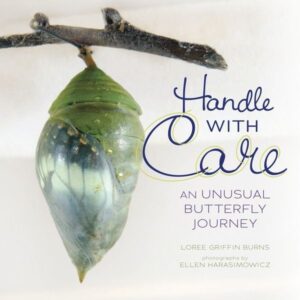 Have you guys seen that Blue Apple Books series where you follow a single object, be it a sphinx or dino bones or an asteroid from discovery (or in some cases, rediscovery) to their place in museums? How the Sphinx Got to the Museum is one such example. Well full credit to the upcoming book Handle with Care: An Unusual Butterfly Journey, since it takes a similar, if distinctly more biological, trip. Starting in El Boxque Nuevo in Costa Rica we see a place where farmers grow butterfly pupae. Why? To ship to museums around the world, of course. What, you think those butterfly exhibits grow themselves? Written by Loree Griffin Burns with photographs by Ellen Harasimowicz, we follow a single butterfly pupae, and then go through all the requisite butterfly lifecycle details. In a market where all the butterfly books kind of blend together, this one’s going to stand out.
Have you guys seen that Blue Apple Books series where you follow a single object, be it a sphinx or dino bones or an asteroid from discovery (or in some cases, rediscovery) to their place in museums? How the Sphinx Got to the Museum is one such example. Well full credit to the upcoming book Handle with Care: An Unusual Butterfly Journey, since it takes a similar, if distinctly more biological, trip. Starting in El Boxque Nuevo in Costa Rica we see a place where farmers grow butterfly pupae. Why? To ship to museums around the world, of course. What, you think those butterfly exhibits grow themselves? Written by Loree Griffin Burns with photographs by Ellen Harasimowicz, we follow a single butterfly pupae, and then go through all the requisite butterfly lifecycle details. In a market where all the butterfly books kind of blend together, this one’s going to stand out.
 We all love the Scientists in the Field series, bar none. I love that series. You love that series. But let’s fact it, they’re not the only scientists out there with books to their names. Plastic, Ahoy! Investigating the Great Pacific Garbage Patch by Patricia Newman (photos by Annie Crawley) at first sounded nothing so much as Tracking Trash: Flotsam, Jetsam, and the Science of Ocean Motion. The difference is the focus. In this book we follow a research expedition studying the accumulation of plastic in the Pacific. Through this story we see a lot of prepwork, including how to live on a ship, sea sickness, cooking, etc.
We all love the Scientists in the Field series, bar none. I love that series. You love that series. But let’s fact it, they’re not the only scientists out there with books to their names. Plastic, Ahoy! Investigating the Great Pacific Garbage Patch by Patricia Newman (photos by Annie Crawley) at first sounded nothing so much as Tracking Trash: Flotsam, Jetsam, and the Science of Ocean Motion. The difference is the focus. In this book we follow a research expedition studying the accumulation of plastic in the Pacific. Through this story we see a lot of prepwork, including how to live on a ship, sea sickness, cooking, etc.
 I’m a big fan of children’s or teen books that do original research not found in adult titles. It’s unclear to me, but this may fall into that category. Secrets of the Sky Caves: Danger and Discovery on Nepal’s Mustang Cliffs is written by Sandra K. Athans. The focus, however, is on her brother, Pete Athans, the mountaineer. Pete’s the kind of guy who climbs Mt. Everest on a regular basis (seven times as of this post) but this book focuses on what happened when he decided to explore the caves of Mustang (pronounced moo-stang). Apparently they’re near impossible to get into, located in remote Nepal. In this book you get to see his discoveries including (and here I’ll quote the catalog text) “murals to ancient texts to human remains”. And they say there’s nothing left to explore anymore . . .
I’m a big fan of children’s or teen books that do original research not found in adult titles. It’s unclear to me, but this may fall into that category. Secrets of the Sky Caves: Danger and Discovery on Nepal’s Mustang Cliffs is written by Sandra K. Athans. The focus, however, is on her brother, Pete Athans, the mountaineer. Pete’s the kind of guy who climbs Mt. Everest on a regular basis (seven times as of this post) but this book focuses on what happened when he decided to explore the caves of Mustang (pronounced moo-stang). Apparently they’re near impossible to get into, located in remote Nepal. In this book you get to see his discoveries including (and here I’ll quote the catalog text) “murals to ancient texts to human remains”. And they say there’s nothing left to explore anymore . . .
 When I was in high school I had an English teacher who let us in on a little secret. Certain movements of the body could be translated to explain what a person was thinking or feeling (God only knows what this had to do with English literature). He showed how showing a palm might mean one thing or where your eyes automatically go when you’re lying. I felt like this was the secret to the universe and if I just knew all these secrets I could rule the world (or, at the very least, become the next Sherlock Holmes). Sadly, there was no book I could find that explained these things. Now Lerner has produced Every Body’s Talking: What We Say Without Words by Donna M. Jackson. It is PRECISELY the book I wanted when I was young. For librarians, this will be the world’s easiest booktalk. Hey, kids! Want to know how to effectively lie to your parents? It’s all here! My co-worker Amie, upon hearing about this book, pointed out that it might actually be of a lot of use to autistic kids or those on the spectrum, since decoding physical bodily clues make up a lot of their existence. Smart thinking there.
When I was in high school I had an English teacher who let us in on a little secret. Certain movements of the body could be translated to explain what a person was thinking or feeling (God only knows what this had to do with English literature). He showed how showing a palm might mean one thing or where your eyes automatically go when you’re lying. I felt like this was the secret to the universe and if I just knew all these secrets I could rule the world (or, at the very least, become the next Sherlock Holmes). Sadly, there was no book I could find that explained these things. Now Lerner has produced Every Body’s Talking: What We Say Without Words by Donna M. Jackson. It is PRECISELY the book I wanted when I was young. For librarians, this will be the world’s easiest booktalk. Hey, kids! Want to know how to effectively lie to your parents? It’s all here! My co-worker Amie, upon hearing about this book, pointed out that it might actually be of a lot of use to autistic kids or those on the spectrum, since decoding physical bodily clues make up a lot of their existence. Smart thinking there.
So you know how I continually vow that I’m not going to report on any YA these days in these previews? Well, that lasts just about as long as it takes to discover awesome YA nonfiction. After that point I’m a puddle. I melt. I am helpless in the face of awesome YA nonfiction. Probably has something to do with the fact that there’s so little of it to choose from. Or, it could be that Lerner comes up with the BEST ideas for books.
Example A: The World Series: Baseball’s Biggest Stage by Matt Doeden. The World Series has a century long history, so it’s fitting that there should be a book out there that looks into it in depth. It covers everything from the wacky moments (“the bloody sock” may mean something to some of you) to the heroic ones. Baseball on the field has pretty much remained the same over the decades. But off the field? The climate has completely changed for the players. Watch the changes take place here.

Example B: Chasing the Storm: Tornadoes Meteorology, and Weather Watching by Ron Miller. Ron, for the record, actually traveled with a group of storm chasers to figure out how they did their work. We’ve tons of fiction in our collections that talks about storm chasers (the “Storm Runners” series by Roland Smith comes to mind) but very little in the nonfiction department. This book shows you not only how to become a storm chaser, but includes information on things like making your own weather station in your backyard. Nicely done.
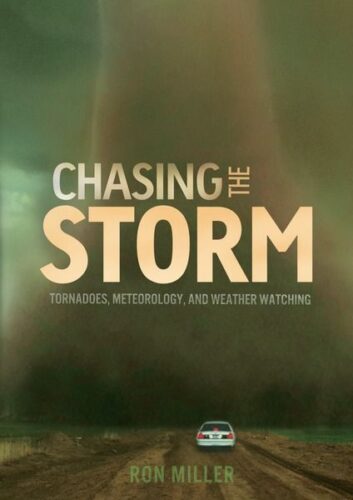
Example C: When a big event takes place and you wonder which major publisher will produce the first really good title on the topic, Lerner’s usually the first to come to mind (check out how quickly they made a book about the latest Pope when he was named last year). In Curiosity’s Mission on Mars: Exploring the Red Planet by (again) Ron Miller, the book looks at Mars from a cultural perspective. Chock full of diagrams and images as well as mentions of past and future missions, this’ll make a nice little companion to books like Cars On Mars and other Mars-centric selections.

Example D: K-Pop: Korea’s Musical Explosion by Stuart A. Kallen. This is one of those cases where you don’t notice a phenomenon until it’s pointed out to you. If you’d asked me prior to the publication of this book to name the top South Korean performers out there, I would have been hard pressed to answer. But there’s Psy and, of course, Rain (whom I think of every time I hear someone mention that current CW show Reign). Historically The Korean War was how American soldiers with their rock and roll introduced the form to the nation. Now it’s huge, and has a book of its very own.

Example E: Years ago I saw this great documentary of found footage called The Atomic Cafe. Oddly, it was the very first place where I learned about the Bikini Islands and what we did to them post-World War II. No books in school ever touched on the topic and no textbook mentioned it. Now Bombs Over Bikini: The World’s First Nuclear Disaster has been written by Connie Goldsmith thanks in large part to a information that was just recently declassified. Between 1948-1956 the United States released 67 nuclear bombs. This is the book that discusses what happened and the accidents that occurred as a result.

Example F: Traumatic Brain Injury: From Concussion to Coma by Connie Goldsmith (who, for the record, is a nurse) is probably as timely as timely could be. But this isn’t just another book about the wide and wonderful world of football related concussions. This book has a much broader approach, looking at the science behind what a concussion is and the different types that occur. Since 52,000 die each year from them (not including all the unrecorded traumatic brain injuries), 1.7 million Americans have been diagnosed with TBI each year. This is the book that looks into what happens and why.

Okay. Enough of that teen stuff. Let’s get some firm footing in the world of children’s books instead.
 There is a legend that surrounds the 18th-century composer Scarlatti (which, in and of itself, is a marvelous name). The story says that his most famous melody was created after he heard his cat walk across the keys of his harpsichord. Scarlatti’s Cat by Nathaniel Lachenmeyer (illustrated by Carlyn Beccia) follows the legend to its logical end. Pulcinella is the cat in question and she dreams of playing her own compositions. It’s not until the timely appearance of a mouse, however, that she gets her big chance. There’s a nice twist at the end on who gets the cat after Scarlatti gives her away. Cute and musical.
There is a legend that surrounds the 18th-century composer Scarlatti (which, in and of itself, is a marvelous name). The story says that his most famous melody was created after he heard his cat walk across the keys of his harpsichord. Scarlatti’s Cat by Nathaniel Lachenmeyer (illustrated by Carlyn Beccia) follows the legend to its logical end. Pulcinella is the cat in question and she dreams of playing her own compositions. It’s not until the timely appearance of a mouse, however, that she gets her big chance. There’s a nice twist at the end on who gets the cat after Scarlatti gives her away. Cute and musical.
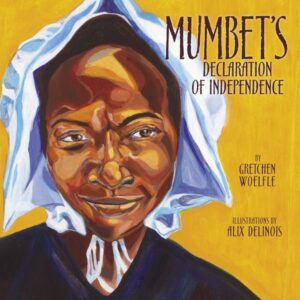 2014 appears to be the year of Mumbet. Next year Harper Collins will produce the young reader’s edition of Founding Mothers: Remembering the Ladies by Cokie Roberts (illustrated by Diane Goode) and there is a brief mention made in that book of Mumbet, a woman I’d never heard of before. Now in Mumbet’s Declaration of Independence by Gretchen Woelfle (illustrated by Alix Delinois) we hear her story. In 1781 a slave in Massachusetts just named Mumbet went to court for her freedom (and her daughters’ for that matter). The amazing thing is that she won the case! Here’s her story.
2014 appears to be the year of Mumbet. Next year Harper Collins will produce the young reader’s edition of Founding Mothers: Remembering the Ladies by Cokie Roberts (illustrated by Diane Goode) and there is a brief mention made in that book of Mumbet, a woman I’d never heard of before. Now in Mumbet’s Declaration of Independence by Gretchen Woelfle (illustrated by Alix Delinois) we hear her story. In 1781 a slave in Massachusetts just named Mumbet went to court for her freedom (and her daughters’ for that matter). The amazing thing is that she won the case! Here’s her story.
 In the past I’ve said that fairytales and folktales are the hardest books to find in a given year. Well, thanks to the efforts of small publishers I no longer believe that to be the case. Now I lament the lack of poetry on our shelves. Poetry, good poetry, is danged hard to find so whenever I hear of something I take note. Lerner has just started the Poetry Adventures series, and they’re kicking off with Brian P. Cleary’s If It Rains Pancakes: Haiku and Lantern Poems. It’s a continuing series, so we’re bound to find more than just these, but they make for a good start. The rules are clearly stated for each poem and the pictures keep things fun.
In the past I’ve said that fairytales and folktales are the hardest books to find in a given year. Well, thanks to the efforts of small publishers I no longer believe that to be the case. Now I lament the lack of poetry on our shelves. Poetry, good poetry, is danged hard to find so whenever I hear of something I take note. Lerner has just started the Poetry Adventures series, and they’re kicking off with Brian P. Cleary’s If It Rains Pancakes: Haiku and Lantern Poems. It’s a continuing series, so we’re bound to find more than just these, but they make for a good start. The rules are clearly stated for each poem and the pictures keep things fun.
 Laura Purdie Salas and Violeta Dabija paired together back in 2012 to make the soft and simple A Leaf Can Be . . . Now they’re back with Water Can Be . . . which follows much along the same lines. This goes through the roles water plays and since it’s incredibly simple (“Water can be a . . . Tadpole hatcher / Picture catcher”) it’s ideal for very early units on water. Basically it does for water what Picture a Tree did for trees. They’ve also paired with Water Aid, so that’s where some of the profits will go.
Laura Purdie Salas and Violeta Dabija paired together back in 2012 to make the soft and simple A Leaf Can Be . . . Now they’re back with Water Can Be . . . which follows much along the same lines. This goes through the roles water plays and since it’s incredibly simple (“Water can be a . . . Tadpole hatcher / Picture catcher”) it’s ideal for very early units on water. Basically it does for water what Picture a Tree did for trees. They’ve also paired with Water Aid, so that’s where some of the profits will go.
 Poetry is hard to find. Graphic novels? Less so. Yet I’m still amazed that more time isn’t spent trying to find great ones for the kiddos. Granted, the good ones can take years and years to make. Still, there are ways around that. I was then very happy to see a new GN series coming out of Lerner. Tao, the Little Samurai by Laurent Richard (illustrated by Nicolas Ryser) is basically a very young Naruto. A boy who excels in pranks and jokes dreams of someday becoming a martial arts master. My only question? How do you pronounce the hero’s name? Is it Tao or Dao? Questions, questions . . .
Poetry is hard to find. Graphic novels? Less so. Yet I’m still amazed that more time isn’t spent trying to find great ones for the kiddos. Granted, the good ones can take years and years to make. Still, there are ways around that. I was then very happy to see a new GN series coming out of Lerner. Tao, the Little Samurai by Laurent Richard (illustrated by Nicolas Ryser) is basically a very young Naruto. A boy who excels in pranks and jokes dreams of someday becoming a martial arts master. My only question? How do you pronounce the hero’s name? Is it Tao or Dao? Questions, questions . . .
 We have lots of middle grade books featuring deadbeat parents, but it can be hard to find just the right balance between stupidity/slime and real affection for their kiddos. The new series “The Berenson Schemes” by Lisa Doan (illustrated by Ivica Stevanovic) takes an interesting tack. In Jack the Castaway a boy has two parents obsessed with get-rich-quick schemes. Perfect. Ideal for fourth graders, it reminds me of nothing so much as “The Unseen World of Poppy Malone” series (parent-wise anyway). Oh. And Jack ends up shipwrecked on a tropical island avoiding a shark. So there’s that too.
We have lots of middle grade books featuring deadbeat parents, but it can be hard to find just the right balance between stupidity/slime and real affection for their kiddos. The new series “The Berenson Schemes” by Lisa Doan (illustrated by Ivica Stevanovic) takes an interesting tack. In Jack the Castaway a boy has two parents obsessed with get-rich-quick schemes. Perfect. Ideal for fourth graders, it reminds me of nothing so much as “The Unseen World of Poppy Malone” series (parent-wise anyway). Oh. And Jack ends up shipwrecked on a tropical island avoiding a shark. So there’s that too.
Last but not least, here’s a smart idea for a very different fiction series. Called “The Cryptid Files” these books by Jean Flitcroft, these stories are of cryptozoology, much as you’d find in Suzanne Selfors’ “Bigfoot Terror Tales”. In each book (starting with The Lock Ness Monster) our heroine Vanessa globe trots trying to finds and prove that cryptids exist.
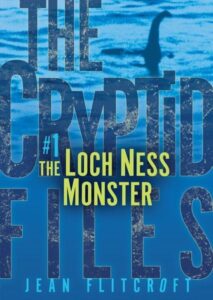
And that’s the long and the short of it folks! Many thanks to Lindsay Matvick for sitting down with me and showing me her wares. Here’s a long and nonfiction heavy 2014!






 Lerner Publishing Group’s Carolrhoda Books occasionally accepts unagented submissions. According to editorial director Andrew Karre, the publisher will take young-adult manuscripts from October 1st until October 31st.
Lerner Publishing Group’s Carolrhoda Books occasionally accepts unagented submissions. According to editorial director Andrew Karre, the publisher will take young-adult manuscripts from October 1st until October 31st.
Follow this link to read all the details and Karre’s instructions. Karre added that he does not like university-aged protagonists, manuscripts that exceeds 100,000 words or books that “have series potential.” He prefers projects that feature unusual people, unfamiliar mythologies and doomed romance.
Karre included three tips for authors: “Things I require: That you follow my submission guidelines. That your cover letter be very brief and you not agonize over it for more than twenty minutes. Your extreme patience. I’m slow. I often return to manuscripts several times before I make a decision.”
New Career Opportunities Daily: The best jobs in media.

By:
Betsy Bird,
on 9/15/2012
Blog:
A Fuse #8 Production
(
Login to Add to MyJacketFlap)
JacketFlap tags:
nonfiction,
Millbrook Press,
nonfiction middle grade,
Lerner Publishing Group,
Rebecca L. Johnson,
2012 reviews,
2012 nonfiction,
2013 Sibert contender,
2012 nonfiction chapter books,
gross books,
Uncategorized,
Add a tag
 Zombie Makers: True Stories of Nature’s Undead
Zombie Makers: True Stories of Nature’s Undead
By Rebecca L. Johnson
Millbrook Press (an imprint of Lerner)
$30.60
ISBN: 978-0761386339
Ages 9 and up
On shelves now
There’s this podcast I like to listen to called RadioLab, which is essentially just a show for people who like kooky science but are still a little foggy on what exactly Einstein’s Theory of Relativity actually means or why the sun is hot. Science for the English majors, let’s call it. Often the show will come up with really original stories, like the guy who purposefully gave himself tapeworms to cure his asthma (it worked). That story came from a show about parasites and it was accompanied by these strange unnerving stories about insects and viruses and worms that could turn their hosts into . . . well . . . zombies, basically. And though I am a children’s librarian, the thought never occurred to me that these stories could, combined with others of the same ilk, create the world’s most awesome work of nonfiction. Fortunately for all of us, Rebecca L. Johnson has not my shortsightedness. In Zombie Makers: True Stories of Nature’s Undead you will meet a whole range of horrifying creatures. It is, without a doubt, probably the grossest book for kids I’ve ever read. And boy howdy let me tell you I have read a LOT Of gross books in my day.
What do you think of when you think of zombies? Do you think of lurching undead ready to feast on your braaaaaains? Or do you think of something a little more insidious like the REASON those zombies don’t seem to have a lot of will of their own? As it happens, zombies are real. Not in the corpse-walker sense, necessarily, but in nature there are plenty of creatures willing to make others into their mindless slaves. Meet the hairworm Paragordius Triscuspidatus, which can convince a perfectly healthy cricket to drown itself. Or Toxoplasma Gondii which, aside from being the reason you’re not supposed to let pregnant women near cat poop, turns rats into suicidal kitty lovers. Page by page author Rebecca Johnson presents us with examples of evolution gone amuck. Zombie makers exist, it’s true, and as their hosts we’d better learn as much as we can about them before they get to us next!
Zombies actually get a lot of play in children’s literature these days. Insofar as I can tell there are two ways to play them. They can’t be romantic like vampires or other members of the monster family so they must either be funny or horrifying. Funny is the route that I’d say 85% of kids’ books about zombies go. Whether you’re talking about Zombiekins or The Zombie Chasers or Undead Ed or any of the other books out there, funny is usually the way to go. I say that, but a lot of what kids want when they enter a library is to be scared. And if you can scare them with real stuff, and maybe even gross them out a little, you are gold, my friend. That’s why this book works as well as it does.
Johnson cleverly sets up the book so that readers can compare and contrast what they know about zombies, zombie talking points let’s say, with these zombie-esque diseases, parasites, and insects. I’d never really thought about Old Yeller as a zombie story, but that’s what it is, isn’t it? A beloved member of the family is bitten by something evil and suddenly the boy who loves it most must put it down before something worse happens. That’s a zombie plot, but it’s Johnson who makes you realize that rabies is just another form of zombie fun. By couching her nonfiction tale within popular zombie fiction tropes, she has an easy in with the child readership.
The writing is superb in and of itself, no doubt, but I wonder if interest in this book would be quite so high if it were not for the accompanying disquieting photographs. The book as an object is beautifully designed from start to finish, which only helps to highlight the photographs found inside. What I really liked about the photos was that they had two different ways of freaking the average reader out. On the one hand you have the photos that go for the immediate ARGGGG! reaction. I am thinking specifically of the worm. The worm that infects human beings. That makes them want to plunge themselves into the water where it breaks out of the skin and leaves the body. Alien much? The image of someone slowly and painfully removing the worm without water is enough to make you lose your lunch. But even better are the photos that elicit a slow dawning sense of horror. The fungus O. unilateralis is a clever beastie, and its greatest trick is in forcing ants to clamp onto leafs and die (but only where the temperature is just right). There’s a shot of a dead ant with a long horrible reproductive stalk emerging out of its head, spreading its spores to other innocent ants. It’s a quiet photo and lacks the urgency and pain of the leg worm shot, but it’s worse somehow. It has this brooding malice to it. You actually do not want to touch the page in the book for fear of somehow touching the fungus. That’s how effective it is.
Children’s librarians often try to lure kids into reading nonfiction by doing what we call booktalks. If you’re a good booktalker you can get your audience to fight over even the dullest looking book. Some books, however, sell themselves. Hold up this book and there’s not a child alive who won’t be instantly fascinated. Describe even one of the stories inside and you might have at last found the book they want even more than the latest edition of Guinness World Records. Informative even as it makes you want to go hide in a clean, sanitized hole somewhere, Johnson has created a clever little book that is bound to keep adult and child readers who find it, enthralled. Ick. Bleach. Awesome.
On shelves now.
Source: Galley borrowed from fellow librarian for review.
Like This? Then Try:
- Scary by Joaquin Ramon Herrera

By:
Betsy Bird,
on 9/4/2012
Blog:
A Fuse #8 Production
(
Login to Add to MyJacketFlap)
JacketFlap tags:
graphic novels,
Uncategorized,
Graphic Universe,
Lerner Publishing Group,
middle grade graphic novels,
2012 reviews,
Best Books of 2012,
2012 graphic novels,
Andres Vera Martinez,
Na Liu,
graphic novel memoirs,
Add a tag
 Little White Duck: A Childhood in China
Little White Duck: A Childhood in China
By Na Liu
Illustrated by Andres Vera Martinez
ISBN: 9780761365877
Graphic Universe (an imprint of Lerner)
$29.27
Ages 9-12
On shelves now.
It’s funny to think about, but the fact of the matter is that we’re still in the early days of the graphic novel memoir for children. Adult graphic novel memoirs are capable of winning top literary awards, like the Pulitzer or the National Book Award. On the kid side of things the options are far more limited. The top literary prize for kids, the Newbery, has never been handed to a comic work, nor does the American Library Association have a prize for comics of any sort. All this comes to mind when I pick up a book like Little White Duck. Couched in the memories of its author, this groundbreaking work is perhaps the finest marriage of world history and comic art for kids I’ve seen in a very long time. A must read for young and old alike.
Told in eight short stories, the book follows Da Qin the middle class daughter of two parents, living in the late 1970s/early 80s. Through her eyes we see a number of small stories about growing up in a post-Mao China. There’s the tale of how she and her younger sister attempted to emulate their nation’s heroes by helping some thirsty chicks (to an unfortunate end, I’m afraid), or the one about having to bring in rat tails to prove she was great at pest control. There’s the story of how Mao’s death affected the nation, and useful facts about China during this era. Most impressive is the titular story about Da Qin and what happened to the white velvet duck on her jacket when she and her father visited the village where he was born. Honest, sometimes funny, and unusually touching, this glimpse into another life in another world rings distinctly true.
 This book has been a reason for serious debate amongst the librarians of my system. Some wondered about the seemingly unconnected stories and whether or not they gelled properly. Others fretted that there wasn’t enough context given about growing up in China during the post-Mao era. Still others wondered about the authenticity. The book was then handed to a co-worker of mine who grew up in China during the same time period as Na Liu she was floored. The details of the book were straight out of her own childhood. She held up one picture to me of popped rice, explaining what it was and how she had never seen it portrayed in a book before. So on the reality front the book certainly ranks an A.
This book has been a reason for serious debate amongst the librarians of my system. Some wondered about the seemingly unconnected stories and whether or not they gelled properly. Others fretted that there wasn’t enough context given about growing up in China during the post-Mao era. Still others wondered about the authenticity. The book was then handed to a co-worker of mine who grew up in China during the same time period as Na Liu she was floored. The details of the book were straight out of her own childhood. She held up one picture to me of popped rice, explaining what it was and how she had never seen it portrayed in a book before. So on the reality front the book certainly ranks an A.
Actually, when I asked my Chinese co-worker to read the book in the first place she was hugely reluctant. Turned out, she just didn’t want to read yet another kid’s book about the Cultural Revolution, and who could blame her? I would say that the vast swath of books for kids set in China are solely interested in Cultural Revolution stuff (stuff that my poor co-worker would be forced to vet time and time again). Part of what makes Little White Duck work is that without didacticism it simply tells a true story about some of the people who were helped by Mao’s rule. Da Qin’s parents were poor and thanks to changes were able to get an education and treated for polio. The book makes no bones about the hungry times under Mao, but it’s rare to get a nuanced view in a work for youth. Heck, the first story in the book is about the massive weeping that occurred in Da Qin’s village when Mao died and about her very realistic child response of crying because everyone else was crying around her. That’s honestly Liu’s greatest strength with this book. She creates universal stories from her youth that anybody can enjoy, even as she sets them in a very specific time and place. That’s why the fact that they are individual stories rather than one overarching storyline work for me. Each one is like a little glimpse into a realistic kid’s life.
 Not to mention the fact that the book deals with class in a remarkable way. I’ve a real penchant for children’s books that know how to deal with class differences. Bad works of children’s literature will usually feature a poor kid hating a rich kid and then inevitably discovering “Gee whiz, we’re not so different after all.”. Smart books for kids handle this enormously complex idea in candid, thoughtful ways. Anna Hibiscus could do it by showing the difference between middle and lower classes in contemporary Nigeria. Little White Duck is the same, using its titular story to tell the tale of Da Qin and her father visiting the poor village where he grew up. Reading that story I went into it confident that I knew how it would work. When Da Qin’s father tells her to go play with the village kids I was sure they’d be mean to her and she’d learn something. Instead they’re perfectly cordial. They are, admittedly, fascinated by the little white velvet duck on her coat and the dirt on their hands coat it black with all their petting. Then for fun, because they can’t afford books like she can, they put sticks up buzzing insects and run about. The next shot is a shell-shocked Da Qin sitting on a train seat while her father asks obliviously, “Did you have a good time?” I loved that. I loved seeing her encounter kids with less at such a young age and coming to an understanding of how lucky she was.
Not to mention the fact that the book deals with class in a remarkable way. I’ve a real penchant for children’s books that know how to deal with class differences. Bad works of children’s literature will usually feature a poor kid hating a rich kid and then inevitably discovering “Gee whiz, we’re not so different after all.”. Smart books for kids handle this enormously complex idea in candid, thoughtful ways. Anna Hibiscus could do it by showing the difference between middle and lower classes in contemporary Nigeria. Little White Duck is the same, using its titular story to tell the tale of Da Qin and her father visiting the poor village where he grew up. Reading that story I went into it confident that I knew how it would work. When Da Qin’s father tells her to go play with the village kids I was sure they’d be mean to her and she’d learn something. Instead they’re perfectly cordial. They are, admittedly, fascinated by the little white velvet duck on her coat and the dirt on their hands coat it black with all their petting. Then for fun, because they can’t afford books like she can, they put sticks up buzzing insects and run about. The next shot is a shell-shocked Da Qin sitting on a train seat while her father asks obliviously, “Did you have a good time?” I loved that. I loved seeing her encounter kids with less at such a young age and coming to an understanding of how lucky she was.
 One librarian I spoke too worried that because there are so few books for kids out there, children reading this book today might assume that it shows contemporary China and not the China of the past. Honestly I don’t think that’s a huge danger. It’s possible that will happen, sure, but Liu covers her bases for the most part, and the brown palette of the art gives everything a historical taste. Now the art poses an interesting question. Created by Texan artist Andres Vera Martinez, this is at least his second foray into graphic novels for kids. The style is perfect for the story too. Filled with details realistic, but also fun, it’s a properly moving tone for a book that is sometimes thoughtful, sometimes sad, sometimes funny, and always interesting. Now that brown palette I alluded to earlier could potentially prove detrimental. There is an understanding out there that kids will not read black and white comics. True. There is also and understanding that kids will not read books with brown covers. Also true. So what do we make of books that are comics colored in a lot of brown? I’m not quite sure but I’m confident that any kid who reads a story or two in the book will be hugely inclined to continue to do so. Good art and writing win out.
One librarian I spoke too worried that because there are so few books for kids out there, children reading this book today might assume that it shows contemporary China and not the China of the past. Honestly I don’t think that’s a huge danger. It’s possible that will happen, sure, but Liu covers her bases for the most part, and the brown palette of the art gives everything a historical taste. Now the art poses an interesting question. Created by Texan artist Andres Vera Martinez, this is at least his second foray into graphic novels for kids. The style is perfect for the story too. Filled with details realistic, but also fun, it’s a properly moving tone for a book that is sometimes thoughtful, sometimes sad, sometimes funny, and always interesting. Now that brown palette I alluded to earlier could potentially prove detrimental. There is an understanding out there that kids will not read black and white comics. True. There is also and understanding that kids will not read books with brown covers. Also true. So what do we make of books that are comics colored in a lot of brown? I’m not quite sure but I’m confident that any kid who reads a story or two in the book will be hugely inclined to continue to do so. Good art and writing win out.
Liu says in the book that she wrote it so that her daughter might get a glimpse into what it was like growing up. Sometimes family stories just aren’t enough. You’ve gotta show, not tell. Even now, when I show a book like this to adults, some of them will say to me, “But what kid would ever read it?”. There’s this continuing perception that unless a comic has superheroes or manga characters it, no kid will want to read it. This does kids a serious injustice. We don’t ask why kids would ever pick up a memoir like Diary of a Young Girl even when there are copies of Harry Potter available. The wonderful thing about kids and comics is that some readers will pick up anything, just so long as there are panels and speech balloons to be had. In other cases you have kids that like comics but aren’t big fiction and fantasy readers. For them we hand over this book. Perhaps the strongest graphic novels for kids of the year and undoubtedly unique, this is one way of teaching world history through a lens that cannot be matched. Thoroughly and entirely remarkable.
On shelves now.
Source: Reviewed from galley sent from publisher.
Like This? Then Try:
By:
smmorris,
on 4/15/2012
Blog:
Kid Lit Reviews
(
Login to Add to MyJacketFlap)
JacketFlap tags:
NetGalley,
Lerner Publishing Group,
5stars,
4stars,
A to Z Challenge 2012,
Carolehoda Books,
Children's Books,
Millbrook Press,
patterns,
Graphic Universe,
leaves,
Add a tag
A to Z Challenge Day 14: N Netgalley is a blogger’s dream. Whether you are beginning, or just cannot get the books you need to review, NetGalley is the best place to join. Anyone who runs a book review site, any genre or age group, will find the books they need. Netgalley and Lerner Publishing [...]
 Fun Fact: Librarian previews done in the presence of small attention seeking babies yield surprisingly drool-soaked notes. Not so drool-soaked that a person couldn’t decipher them later, but wet with the moisture of someone else’s mouth just the same.
Fun Fact: Librarian previews done in the presence of small attention seeking babies yield surprisingly drool-soaked notes. Not so drool-soaked that a person couldn’t decipher them later, but wet with the moisture of someone else’s mouth just the same.
Still and all, the good people of Lerner Publishing Group (Lindsay Matvick and Terri Reden if you want to get specific) weren’t exactly unaware of the effects babies have on one’s output. Hence the tardiness of this post, I suppose. They sat down with me at my favorite local chocolate cafe (Lily O’Brien’s, in case you ever want to meet with me too) and showed me what the Spring 2012 season has to offer. Everything from real world alien investigations to real world stories about never forgotten Harlem bookstores. 2012 is shaping to be a heckuva year.
 First up, the Tana Hoban of the 21st century. At least that’s how I dub British crafty blogger Jane Brocket. Color photography may date to a certain extent, but Tana Hoban’s books still circulate like nobody’s business. Like Hoban, Brocket has an eye for concepts and she complements each one with lush photography. Her newest is Spotty, Stripy, Swirly: What Are Patterns? Pretty self-explanatory, except that I wonder if the title is slightly different overseas. They’ve a rather different view of the term “spotty” if my Harry Potter has taught me anything.
First up, the Tana Hoban of the 21st century. At least that’s how I dub British crafty blogger Jane Brocket. Color photography may date to a certain extent, but Tana Hoban’s books still circulate like nobody’s business. Like Hoban, Brocket has an eye for concepts and she complements each one with lush photography. Her newest is Spotty, Stripy, Swirly: What Are Patterns? Pretty self-explanatory, except that I wonder if the title is slightly different overseas. They’ve a rather different view of the term “spotty” if my Harry Potter has taught me anything.
 First came joeys. Then larvae. Now Bridget Heos is back with Stephane Jorisch (a fellow you may now know best from the Betty Bunny books) for What to Expect When You’re Expecting Hatchlings: A Guide for Crocodilian Parents (and Curious Kids). The book covers facts about crocs and their offspring. Makes me wonder if Ms. Heos will start covering some of those animals we get requests for all the time like bats or sharks. Shark Week is every week in the public library. Note, by the way, that there is (or will be) free material on the Lerner website to accompany this book.
First came joeys. Then larvae. Now Bridget Heos is back with Stephane Jorisch (a fellow you may now know best from the Betty Bunny books) for What to Expect When You’re Expecting Hatchlings: A Guide for Crocodilian Parents (and Curious Kids). The book covers facts about crocs and their offspring. Makes me wonder if Ms. Heos will start covering some of those animals we get requests for all the time like bats or sharks. Shark Week is every week in the public library. Note, by the way, that there is (or will be) free material on the Lerner website to accompany this book.
 Lerner has some similarities to those publishers that just crank out titles covering subjects that kids are assigned in schools all the time. The difference is that their series titles tend to be pretty good. Recently they started putting out a series that covers different breeds of dogs and cats. I sort of assumed that was the end of it and that we wouldn’t hear any more. Not at all! Behold the new “My Favorite Horses” series. Covering American Quarter Horses, Appaloosas, Lipizzans (like in The Star of Kazan by Eva Ibbotson!), Morgan Horses, and Shetland Ponies (no Assateagues?), the books discuss everything from breed history to info on riding and owning your own horse. Consider purchasing for the ho
Lerner has some similarities to those publishers that just crank out titles covering subjects that kids are assigned in schools all the time. The difference is that their series titles tend to be pretty good. Recently they started putting out a series that covers different breeds of dogs and cats. I sort of assumed that was the end of it and that we wouldn’t hear any more. Not at all! Behold the new “My Favorite Horses” series. Covering American Quarter Horses, Appaloosas, Lipizzans (like in The Star of Kazan by Eva Ibbotson!), Morgan Horses, and Shetland Ponies (no Assateagues?), the books discuss everything from breed history to info on riding and owning your own horse. Consider purchasing for the ho
Zombie Cows!by Michael Broad
2011 | 144 pages | Chapter Book
*I received a digital ARC of this book from NetGalley.
Zombie Cows is the second book in the Agent Amelia series, a collection of chapter books originally published in the UK that are now making their way to the US thanks to Lerner Publishing Group. Each book in the series contains three episodes in which Amelia Kidd, a child secret agent, must fight evil and ego-maniacal villains who want to take over the world. In this book, the episodes are entitled "The Case of the Zombie Cows", "The Case of the Perilous Pipe" and "The Case of the Creepy Cakes."
In "The Case of the Zombie Cows", Amelia is at a petting zoo with her mother when she encounters some strange mechanical farm animals. In "The Case of the Perilous Pipe" a substitute teacher's strange musical instrument seems to have a strong, creepy hold over many of the students. And in "The Case of the Creepy Cakes", Amelia visits a bakery where the owners are trying to make everyone fat. Each of the villains is comical and easily beaten once Amelia is able to convince him or her to brag about his/her plan for world domination. The bad guys in each of these stories reminded me of some of Roald Dahl's villains, or of someone like Count Olaf from the Series of Unfortunate Events books. They are evil through and through, but it's still believable that a child can defeat them.
The language in this book is very straightforward with no extraneous frills, making it a great choice for new chapter book readers. Each story is fast-paced and well-plotted, and Amelia's sense of humor and intelligence kept me turning the pages so quickly I finished the book in one sitting. Hers is a unique voice that stands out from other chapter book heroines, and while the setting of the stories is familiar, the focus on spying and bringing down forces of evil will attract kids who like adventure and mystery stories. This is one of those series that will appeal to boys and girls, and to reluctant readers as well.
Zombie Cows will be released in the US on October 1, 2011.

View Next 4 Posts
 Don’t Call Me Grandma
Don’t Call Me Grandma First and foremost, this is not a fuzzy grandparent (or great-grandparent) book. There are plenty of fuzzy books out there, filled to brimming with warm snuggly feelings. If that is the kind of book you require then grab yourself the nearest Nancy Tillman and content yourself accordingly. What we have here instead is a kind of character study. Whatever expectations you carry into this book, they will be upended by the text. Nell is an amazing character, one that I’ve never seen in book of this sort. Her prickly nature may well hide that “broken heart” she mentions obliquely, but it could just as easily hide more prickles. We get three distinct memories of her past, but it’s a single wordless two-page spread that probably says more about her than anything else. As an adult, I found myself speculating about her life. How perhaps she had dreams of dancing professionally but that she put those dreams aside when she had her children at a very young age. No kid is going to read into Nell what I have. That’s what makes reading this book so dynamic. Come for the prickly relative. Stay for the enticing, unknowable back story.
First and foremost, this is not a fuzzy grandparent (or great-grandparent) book. There are plenty of fuzzy books out there, filled to brimming with warm snuggly feelings. If that is the kind of book you require then grab yourself the nearest Nancy Tillman and content yourself accordingly. What we have here instead is a kind of character study. Whatever expectations you carry into this book, they will be upended by the text. Nell is an amazing character, one that I’ve never seen in book of this sort. Her prickly nature may well hide that “broken heart” she mentions obliquely, but it could just as easily hide more prickles. We get three distinct memories of her past, but it’s a single wordless two-page spread that probably says more about her than anything else. As an adult, I found myself speculating about her life. How perhaps she had dreams of dancing professionally but that she put those dreams aside when she had her children at a very young age. No kid is going to read into Nell what I have. That’s what makes reading this book so dynamic. Come for the prickly relative. Stay for the enticing, unknowable back story. The child in this book is much like the child who will be reading it with an adult. Both she and they sense that there is more at work here than meets the eye. And it is the art by Elizabeth Zunon that backs that feeling up. Elizabeth Zunon has been a force to reckon with for years. I first noticed her when she illustrated William Kamkwamba’s The Boy Who Harnessed the Wind, though I unknowingly had already been a fan of hers when she illustrated Jeanne Harvey’s My Hands Sing the Blues. In Don’t Call Me Grandma she begins with a straightforward contemporary story. Even then, her endpapers start telling the tale long before the words do (not counting the title). She fills these early pages with strings of pearls. Fat pearls, small pearls, pink and gray and white pearls. Note that in the text there is just one mention of those pearls, and it’s in the context of a lot of other things on Nell’s dressing table. But Zunon is getting a grip on her personality in her own way. Because of her we get a distinct sense of Great-Grandmother’s style, poise, and dignity. There are fun little details too, like the family peering out through the window as Nell gives a singing bird what for and how to. Zunon also lends Nell a humanity on the sidelines. When her great-granddaughter looks around her room we see Nell observing affectionately from the sides (though she’d be the first to deny it if you accosted her with the evidence). Then there are the memories. Depicted as splotchy watercolors, Zunon subtly changes her style to indicate how some memories are crystal clear even as they blur and go soft around the edges. The two-page spread of objects representing other memories (everything from photographs of Civil Rights marchers to tickets to an Alvin Ailey ballet) will require giving child readers some context. Nothing wrong with that. Sit them down and explain each thing you see. Don’t recognize something? Look it up!
The child in this book is much like the child who will be reading it with an adult. Both she and they sense that there is more at work here than meets the eye. And it is the art by Elizabeth Zunon that backs that feeling up. Elizabeth Zunon has been a force to reckon with for years. I first noticed her when she illustrated William Kamkwamba’s The Boy Who Harnessed the Wind, though I unknowingly had already been a fan of hers when she illustrated Jeanne Harvey’s My Hands Sing the Blues. In Don’t Call Me Grandma she begins with a straightforward contemporary story. Even then, her endpapers start telling the tale long before the words do (not counting the title). She fills these early pages with strings of pearls. Fat pearls, small pearls, pink and gray and white pearls. Note that in the text there is just one mention of those pearls, and it’s in the context of a lot of other things on Nell’s dressing table. But Zunon is getting a grip on her personality in her own way. Because of her we get a distinct sense of Great-Grandmother’s style, poise, and dignity. There are fun little details too, like the family peering out through the window as Nell gives a singing bird what for and how to. Zunon also lends Nell a humanity on the sidelines. When her great-granddaughter looks around her room we see Nell observing affectionately from the sides (though she’d be the first to deny it if you accosted her with the evidence). Then there are the memories. Depicted as splotchy watercolors, Zunon subtly changes her style to indicate how some memories are crystal clear even as they blur and go soft around the edges. The two-page spread of objects representing other memories (everything from photographs of Civil Rights marchers to tickets to an Alvin Ailey ballet) will require giving child readers some context. Nothing wrong with that. Sit them down and explain each thing you see. Don’t recognize something? Look it up!




















































 Tao, the Little Samurai #1: Pranks and Attacks!
Tao, the Little Samurai #1: Pranks and Attacks! 



































































































 Lerner Publishing Group’s Carolrhoda Books occasionally accepts unagented submissions. According to editorial director Andrew Karre, the publisher will take young-adult manuscripts from October 1st until October 31st.
Lerner Publishing Group’s Carolrhoda Books occasionally accepts unagented submissions. According to editorial director Andrew Karre, the publisher will take young-adult manuscripts from October 1st until October 31st.










I’m starting a campaign: Zunon for 2017 Caldecott.
I also loved Elizabeth’s art for One Plastic Bag by Miranda Paul.
This was definitely an intriguing picture book, with a pleasing repetitive structure always beginning with Great Grandmother Nell is … I also loved the circular structure to the story. It begins with her being scary, and ends with her still being scary and yet we’ve grown, as the narrator has to appreciate her prickliness and spunk as we see their developing bond through the sensory details that are presented.
My grandmother’s dressing table, with its powder puffs and perfumes and little pots of rouge, and her dresser with photos of people wearing enigmatic smiles! This brings it all back (tho I wasn’t afraid of my Grandma, only of her creepy fox marten stole).